List of PDO products by country
This is a list of Protected Designation of Origin (PDO) products by country. Protected Designation of Origin is a Geographical Indication under EU and UK law. Applications can be made both for EU/UK product designation and for other territories. The EU publishes its designations in GI View.[1]
Multiple countries
For a limited number of products, the PDO status is registered with regards to a geographical area which comprises (parts of) two countries. They are listed below:
| Product name | Area | Short description | Image |
|---|---|---|---|
Istra
|
parts of Croatian and Slovenian Istria | Istra is an extra-virgin olive oil, produced in an area where olive trees have been present since Ancient Roman times. The olive oil is bitter and has a high oleic acid content (generally >74 %) and linolenic acid <10 %.[2]
|
|
Istarski pršut / Istrski pršut
|
parts of Croatian and Slovenian Istria | Istarski pršut (Croatian) / Istrski pršut (Slovenian) is a "dry-cured meat product made of a pig's ham without the foot, the skin and the subcutaneous fat but with the pelvic bones, which is dry-brined with sea salt and spices, air-dried without smoking and then dried and matured for at least 12 months", which is similar to prosciuto.[3]
|
|
Maasvallei Limburg
|
Meuse Valley at the border of the Netherlands and Belgium | Maasvallei Limburg is a wine comprising parts of the areas surrounding the "shingle Maas", the Meuse where it forms the physical border between the Netherlands and Belgium. The area is part of the Dutch province Limburg as well as the Belgian province Limburg. Grapes from which the wine may be produced are Acolon, Auxerrois, Chardonnay, Dornfelder, Gewürztraminer, Pinot Blanc, Pinot Gris, Pinot Noir, Riesling and Siegerrebe.[4] | |
| Miód z Sejneńszczyny / Łoździejszczyzny / Seinų / Lazdijų krašto medus | Sejny and Suwałki county in Poland and Lazdijai District Municipality in Lithuania | Miód z Sejneńszczyny is a bees' honey from polyfloral nectar, which received a PDO designation in 2012.[5] |
Austria
| Product name | Area | Short description | Image |
|---|---|---|---|
| Sura Kees | Montafon valley in Vorarlberg (Austria)
|
Sura Kees (Alemannic: "sour cheese"), also known as Vorarlberger Sauerkäse or Montafoner Sauerkäse is a low-fat sour milk cheese originally from the Montafon valley in Vorarlberg (Austria). It is traditionally made from skim milk and is a by-product of butter production. Sura Kees resembles the Tyrolean Grey Cheese. The registration of the PDO states that its production has been a significant element of Vorarlberg's peasant gastronomy for centuries. Sura Kees is usually served with vinegar, oil and onions, pure on black bread or eaten with potatoes.[6] |  |
| Tiroler Graukäse | Tyrolean Alp valleys (Austria). | Tyrolean grey cheese (Graukäse) is a strongly flavoured, rennet-free cows-milk acid-curd cheese made in the Tyrolean Alp valleys, Austria. It owes its name to the grey mold that usually grows on its rind. It is extremely low in fat (around 0.5%) and it has a powerful penetrating smell. The cheese is registered as protected designation of origin under the official name Tiroler Graukäse g.U.[7] The registration of the PDO states that its production has been a significant element of Tyrolean peasant gastronomy for centuries. Graukäse making became widespread on farms due to the simplicity of making and the availability of low-fat milk after the fat had been taken for use in butter making.[8] |  |
Tiroler Speck
|
Tyrol | Tyrolean Speck is a distinctively juniper-flavored ham originally from Tyrol, a historical region that since 1918 partially lies in Italy. Its origins at the intersection of two culinary worlds is reflected in its synthesis of salt-curing and smoking. The first historical mention of Tyrolean Speck was in the early 13th century when some of the current production techniques were already in use. Südtiroler Speck (Italian: Speck Alto Adige) is now a protected geographic designation with PGI status.[9] |  |
| Vorarlberger Bergkäse | Vorarlberg | Vorarlberger Bergkäse ("Vorarlberg mountain cheese") is a regional cheese specialty from the Austrian state of Vorarlberg. It is protected within the framework of the European designation of origin (PDO).[10][11] |  |
Belgium
In Belgium, since 2011, the Public Service of Wallonia, the Quality Department of the Operational Directorate-General for Agriculture and Natural Resources and the Environment (DGARNE), has set up CAIG; a program dedicated to geographical indication of produce.[12] This project is carried out jointly by the University of Liège (Laboratory for Quality and Safety of Agrifood Products, Gembloux Agro-Bio Tech[13]) and the University of Namur (Department of History, Pole of Environmental History[14]). The objective of the CAIG is to support the Walloon producer groups wishing to submit an application for recognition of their product as a Protected Designation of Origin (PDO), Protected Geographical Indication (PGI) or Traditional Specialty Guaranteed (TSG). To do this, CAIG supports producers in their process of drafting specifications and in the work of characterizing the product.
| Product name | Area | Short description | Image |
|---|---|---|---|
| Beurre d'Ardenne | Ardenne
|
Beurre d'Ardenne is a type of |
Bulgaria
| Product name | Area | Short description | Image |
|---|---|---|---|
Българско бяло саламурено сирене / Bulgarsko byalo salamureno sirene
|
Bulgaria | Българско бяло саламурено сирене / Bulgarsko byalo salamureno sirene is a type of brined cheese originating from Bulgaria, and which is a brined cheese as is also common in the Balkans. It is made entirely from or from a mixture of goat, sheep, cow or buffalo milk. It is slightly crumbly, with at least 46–48% dry matter containing 44–48% fat. It is commonly produced in blocks, and has a slightly grainy texture. It is used as a table cheese, in salads, and in baking.[17] | 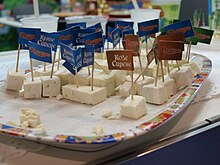 |
China
| Product name | Area | Short description | Image |
|---|---|---|---|
| 龍井茶 / 龙井茶 / Longjing cha | Xihu, Qiantang and Yuezhou in Zhejiang
|
Longjing cha (龍井茶 or 龙井茶) is a green tea characterized by "its green colour, rich aroma, sweet aftertaste, and its beautiful flat, smooth and straight appearance".[18] | 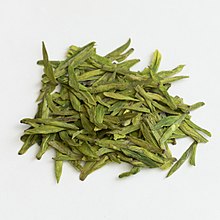 |
Cyprus
| Product name | Area | Short description | Image |
|---|---|---|---|
| Halloumi/Χαλλούμι/Hellim | Cyprus | Halloumi (Χαλλούμι in Greek, Hellim in Turkish) is a brined cheese that originates from Cyprus. It's traditionally made from sheep's and goat's milk, but sometimes cow's milk is also used. What makes halloumi unique is its high melting point, which allows it to be grilled, fried, or baked without melting or losing its shape. This also gives it a characteristically squeaky texture when you bite into it.[19]
The earliest known surviving descriptions of Cypriot halloumi were recorded in the mid-16th century. |
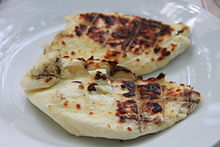 |
Denmark
| Product name | Area | Short description | Image |
|---|---|---|---|
| Dons | Dons valley (near Kolding) in Southern Denmark | Dons is a wine from the Dons valley, a valley of glacial origin. The wine is produced from grapes (mainly Zalas Perle, Cabernet Cortis, Orion, Madeleine Angevine, Solaris, Rondo, Regent, Pinot Noir) at a maximum of 5000 kg/hectare.[20] |
Finland
| Product name | Area | Short description | Image |
|---|---|---|---|
Lapin puikula
|
Lapland (Finland) | Lapin puikula is a type of potato grown in Lapland, and adjusted to the cold climatic conditions.[21] | 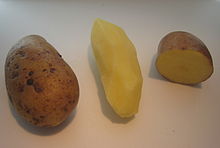 |
France
| Product name | Area | Short description | Image |
|---|---|---|---|
| Abondance | Haute-Savoie | Abondance is a semi-hard, fragrant, raw-milk Abondance, montbéliarde, and tarine breeds of cattle. By 2022, the herd producing the milk for Abondance cheese will need to be a minimum of 55 percent of the herd.[22][clarification needed] In 1998, 873 tonnes were produced (+16.4 percent since 1996), 34 percent from local farms. Abondance cheese was granted an Appellation d'origine contrôlée or AOC in 1990.[23]
|
 |
| Jambon de Bayonne | Bayonne | Bayonne ham or jambon de Bayonne is a cured cultural regions of Basque Country and Gascony . It has PGI status.
|
 |
| Beaufort | Savoie | Beaufort (French pronunciation: Tarentaise valley and Maurienne, which are located in the Savoie region of the French Alps.[25] Beaufort was first certified as an appellation d'origine contrôlée in 1968.[26][27]
|
 |
| Beurre d'Isigny | Isigny-sur-Mer | Beurre d'Isigny is a type of cow's milk butter made in the PDO status in 1996.[30]
|
 |
| Bleu d'Auvergne | Auvergne
|
Bleu d'Auvergne (French: cow's milk,[32] and is one of the cheeses granted the Appellation d'origine contrôlée from the French government. Bleu d'Auvergne was developed in the mid-1850s by a French cheesemaker named Antoine Roussel.[32] Roussel noted that the occurrence of blue molds on his curd resulted in an agreeable taste, and conducted experiments to determine how veins of such mold could be induced.[32] After several failed tests, Roussel discovered that the application of rye bread mold created the veining, and that pricking the curd with a needle provided increased aeration.[32] The increased oxygenation enabled the blue mold to grow in the pockets of air within the curd.[32] Subsequently, his discovery and techniques spread throughout the region. Today, bleu d'Auvergne is prepared via mechanical needling processes. It is then aged for approximately four weeks in cool, wet cellars before distribution, a relatively short period for blue cheeses.
|
 |
| Brie de Meaux | Brie region | Brie de Meaux is a French brie cheese of the Brie region and a designated AOC (now PDO) product since 1980.[33] Its name comes from the town of Meaux in the Brie region. As of 2003, 6,774 tonnes (-13.4% since 1998) were produced annually. | 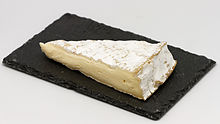 |
| Brocciu Corse / Brocciu | Brocciu is a Corsican cuisine, it is used in the preparation of innumerable dishes, from first courses to desserts.[38]
|
 | |
| Camembert de Normandie | Normandy | Camembert de Normandie (French: . | 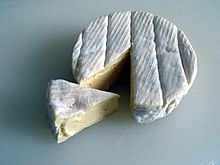 |
| Cantal / Fourme de Cantal | Auvergne | Cantal / Fourme de Cantal is an uncooked firm AOC, 1956.[42]
|
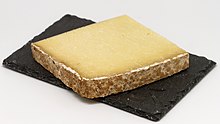 |
| Chabichou du Poitou | France | Chabichou du Poitou (also known as Poitou) is a traditional semi-soft, unpasteurized, natural-rind French Protected Designation of Origin regulations to be produced using pasteurized milk.[44] Chabichou is very white and smooth, and flexible to the palate, with a fine caprine odor.
|
 |
| Champagne | France | Champagne (French: Pinot meunier, and Chardonnay are primarily used to produce almost all Champagne, but small amounts of Pinot blanc, Pinot gris, Arbane, and Petit Meslier are vinified as well. Only these specific grapes grown according to appellation rules on designated plots of land within the appellation may be used to make Champagne. Champagne became associated with royalty in the 17th, 18th, and 19th centuries. The leading manufacturers made efforts to associate their Champagnes with nobility and royalty through advertising and packaging, which led to its popularity among the emerging middle class.[46]
|
bubbles associated with the wine |
| Chaource | Chaource | Chaource is a Appellation d'Origine Contrôlée (AOC) cheese in 1970 and has been fully regulated since 1977.
|
 |
| Chevrotin | Savoy | Chevrotin is a soft | 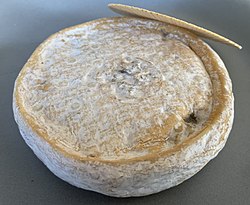
|
| Comté | Franche-Comté | Comté (or FDM around 45%. The rind is usually a dusty-brown colour, and the internal paste, pâte , is a pale creamy yellow. The texture is relatively hard and flexible, and the taste is mild and slightly sweet.
|
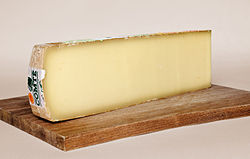
|
| Crottin de Chavignol / Chavignol | Loire Valley | Crottin de Chavignol is a Chavignol, France, which has only two hundred inhabitants. Protected by the AOC Seal,[51] Crottin de Chavignol is produced today with traditional methods. If a cheese is labelled "Crottin de Chavignol", it has to be from the area around Chavignol, and it has to meet the stringent AOC production criteria.
|
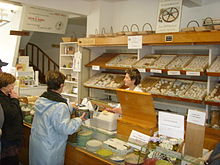 |
Époisses
|
Époisses | Époisses, also known as Époisses de Bourgogne (French: washed rind" (washed in brine and Marc de Bourgogne, the local pomace brandy), it is circular at around either 10 cm (3.9 in) or 18 cm (7.1 in) in diameter, with a distinctive soft red-orange color. It is made either from raw or pasteurized milk.[52] It is sold in a circular wooden box, and in restaurants, is sometimes served with a spoon due to its extremely soft texture. The cheese is often paired with Trappist beer or even Sauternes rather than a red wine.[citation needed ]
|
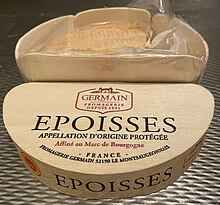 |
| Figue de Solliès | Solliès-Pont | Figue de Solliès is a fig variety grown in the Var department in the Provence-Alpes-Côte d'Azur region in southeastern France. It accounts for 75% of the fig market in France. The fruit is shaped like a crushed teardrop, with a violet exterior and a glossy, dark red interior containing numerous beige seeds. The smell has notes of watermelon, honeydew melon, and strawberries.[53][54][55]
|

|
| Fourme de Montbrison | Montbrison | Fourme de Montbrison is a cow's-milk Appellation d'Origine Contrôlée status was granted in 1972 under a joint decree with Fourme d'Ambert, a similar blue cheese also from the same region. In 2002 the two cheeses received AOC status in their own right, recognizing the differences in their manufacture.[59] With a musty scent, the cheese is extremely mild for a blue cheese and has a dry taste.
|

|
| Laguiole cheese | Aveyron
|
Laguiole (French pronunciation: Appellation d'Origine Contrôlée (AOC) since 1961 and by the amended decree in 1986. Laguiole is said to have been invented at a monastery in the mountains of Aubrac in the 19th century. According to historical accounts, the monks passed down the recipe for making this cheese from cattle during the alpages to the local buronniers, the owners of burons, or mountain huts.
|
 |
| Langres cheese | Langres | Langres is a Époisses , its local competition. It is best eaten between May and August after five weeks of aging, but it is also excellent March through December. Production in 1998 was around 305 tons, a decline of 1.61% since 1996, and 2% on farms.
|
 |
Ail rose de Lautrec
|
Lautrec | Lautrec Pink Garlic protected geographical indication ail rose de Lautrec (Lautrec Pink Garlic) since 12 June 1996.[64]
|
 |
Lentille verte du Puy
|
Le Puy | Le Puy green lentil is a small, mottled, slate-gray/green |  |
| Livarot cheese | Livarot | Livarot is a washed rind cheese made from Normande cow's milk. The normal weight for a round of Livarot is 450 g, though it also comes in other weights. It is sold in cylindrical form with the orangish rind wrapped in 3 to 5 rings of dried reedmace (Typha latifolia). For this reason, it has been referred to as 'colonel', as the rings of dried bullrush resemble the stripes on a colonel's uniform. Sometimes green paper is also used. Its orange colour comes from different sources depending on the manufacturer, but is often annatto. The bacterium Brevibacterium linens is employed in fermentation. Production in 1998 was 1,101 tons, down 12.2% since 1996. Only 12% of Livarot are made from raw, unpasteurised milk. Its period of optimal tasting is spread out from May to September after a refining from 6 to 8 weeks, but it is also excellent from March to December.
|
 |
| Maroilles / Marolles | Picardy | Maroilles (pronounced mar wahl, also known as Marolles) is a cow's-milk AOC regulations, cheeses eligible for AOC status can be one of three other sizes:
|
 |
| Morbier | Morbier | Morbier is a semi-soft cows' milk cheese of France named after the small village of Morbier in Franche-Comté.[70] It is ivory colored, soft and slightly elastic, and is immediately recognizable by the distinctive thin black layer separating it horizontally in the middle.[70] It has a yellowish, sticky rind.[71]
The aroma of Morbier cheese is mild, with a rich and creamy flavour.[72] It has a semblance to Raclette cheese in consistency and aroma.[citation needed] The Jura and Doubs versions both benefit from an appellation d'origine contrôlée (AOC), though other non-AOC Morbier exist on the market.[citation needed] |

|
| Munster / Munster-Géromé | Vosges | Munster (French pronunciation: Alsace-Lorraine and Franche-Comté regions in France.[73] The name "Munster" is derived from the Alsace town of Munster , where, among Vosgian abbeys and monasteries, the cheese was conserved and matured in monks' cellars.
|
 |
| Neufchâtel | Neufchâtel-en-Bray | Neufchâtel (French: It is usually sold in heart shapes but is also produced in other forms, such as logs and boxes. It is typically matured for 8–10 weeks and weighs around 100 to 600 g. |  |
| Olive de Nice | Nice | The Olive de Nice is an olive from the Alpes-Maritimes area of France. The specification states that they must be of the Cailletier variety, and harvest must not exceed 6 tons per hectare. |  |
| Ossau-Iraty | Basque | Ossau-Iraty is an sheep milk. It has been recognized as an appellation d'origine contrôlée (AOC) product since 1980. It is one of three sheep's milk cheeses granted AOC status in France (the others are Roquefort and Brocciu). It is of ancient origin, traditionally made by the shepherds in the region.[76]
|
 |
| Pélardon | Cévennes | Pélardon, formerly called paraldon, pélardou and also péraudou, is a Pélardon is registered as a PDO since August 2000. |  |
| Picodon | Rhône | Picodon is a goats-milk cheese made in the region around the Rhône in southern France. The name means "spicy" in Occitan.[78] The cheese itself comes in a number of varieties, each small, flat and circular in shape varying from speckled white to golden in colour. Between 5 and 8 cm (2.0 and 3.1 in) in diameter and between 1.8 and 2.5 cm (0.71 and 0.98 in) in height, they range from around 40 to 100 grams. The pâte of the cheese is spicy and unusually dry, whilst retaining a smooth, fine texture. Whilst young the cheese has a soft white rind and has a gentle, fresh taste. If aged for longer, the cheese can lose half of its weight resulting in a golden rind with a much harder centre and a more concentrated flavour. |  |
| Pont-l'Évêque | Pont-l'Évêque | Pont-l'Évêque is a Appellation d'Origine Contrôlée (AOC) cheese on 30 August 1972, reaching full status in 1976. Its production was defined and protected with a decree of 29 December 1986.[80] Le Petit Futé guides commend that the best AOC Pont-l'évêque comes from the Pays d'Auge, which includes the Canton of Pont-l'Evêque itself.[81][82]
|
 |
| Pouligny-Saint-Pierre | Indre | Pouligny-Saint-Pierre is a French goats'-milk cheese made in the Indre department of central France. Its name is derived from the commune of Pouligny-Saint-Pierre in the Indre department where it was first made in the 18th century. The cheese is distinctive, being pyramidal in shape and golden brown in colour with speckles of grey-blue mould, and is often known by the nicknames "Eiffel Tower" or "Pyramid". It has a square base 6.5 cm wide, is around 9 cm high, and weighs 250 grams (8.8 oz).[83] The central pâte is bright white with a smooth, crumbly texture that mixes an initial sour taste with salty and sweet overtones. The exterior has a musty odour reminiscent of hay. It is made exclusively from unpasteurised milk. Both fermier (farmhouse) and industriel (dairy) production is used with the fermier bearing a green label, and industriel a red label. Its region of production is relatively small, taking in only 22 communes. |  |
| Reblochon / Reblochon de Savoie | Savoie | Reblochon (French pronunciation: AOC designation. Reblochon was first produced in the Thônes and Arly valleys, in the Aravis massif. Thônes remains the centre of Reblochon production; the cheeses are still made in the local cooperatives. Until 1964 Reblochon was also produced in Italian areas of the Alps. Subsequently, the Italian cheese has been sold in declining quantities under such names as Rebruchon and Reblò alpino.
|
 |
| Rocamadour | Rocamadour | Rocamadour is a Lot. Rocamadour belongs to a family of goat cheeses called Cabécous and has benefited from being accorded an AOC (appellation d'origine contrôlée ) designation since 1996. It is a very small whitish cheese (average weight 35 g) with a flat round shape (see illustration). Rocamadour is usually sold very young after just 12–15 days of aging and is customarily consumed on hot toast or in salads. Rocamadour can be aged further. After several months it takes on a more intense flavor and is typically eaten on its own with a red wine toward the end of the meal. Production: 546 tonnes in 1998 (+24.1% since 1996), 100% with raw, unpasteurized goat milk (50% on farms).
|
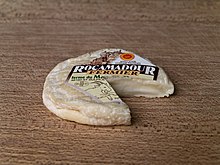 |
| Roquefort | Roquefort-sur-Soulzon | Roquefort is a Appellation d'Origine Contrôlée when regulations controlling its production and naming were first defined.[87] In 1961, in a landmark ruling that removed imitation, the Tribunal de Grande Instance at Millau decreed that, although the method for the manufacture of the cheese could be followed across the south of France, only those cheeses whose ripening occurred in the natural caves of Mont Combalou in Roquefort-sur-Soulzon were permitted to bear the name Roquefort.[88]
|
 |
| Saint-Nectaire | Auvergne
|
Saint-Nectaire is a Auvergne region of central France. The cheese has been made in Auvergne since at least the 17th century. Saint-Nectaire is an Appellation d'origine contrôlée (AOC), a certification given to French agricultural products based on a set of clearly defined standards. For example, it must be made of cow's milk in a specifically delimited area in the Monts-Dore region. The Appellation was first recognized at a national level and awarded AOC status in 1955.[89] At that time, the Saint-Nectaire cheese was only produced on farms from milk from their own cows. When the appellation was accorded, industrial milk and dairy factories were also allowed to produce Saint-Nectaire. To differentiate between products made from the two processes, farmstead cheeses are marked with a small oval label in green casein, while a square label is applied to industrial cheeses. In 1996, a Protected Designation of Origin (PDO) was given to Saint-Nectaire, extending name protection to the entire European Union. A new appellation, "petit-Saint-Nectaire" (meaning "small Saint-Nectaire"), given to cheeses that weigh 600 grams, was later included in the specifications.
|
 |
| Selles-sur-Cher | Centre-Val de Loire | Selles-sur-Cher is a French AOC status in 1975.[92] According to its AOC regulations, the cheese must be made within certain regions of the departments of Cher, Indre and Loir-et-Cher .
|
 |
| Valençay | Berry
|
Valençay is a its wine.[93]
|
 |
Germany
Greece
| Product name | Area | Short description | Image |
|---|---|---|---|
| Φέτα / Feta | Greece | Feta ( |  |
| Φιρίκι Πηλίου / Firiki Piliou | Greece | Firiki Piliou ("Φιρίκι Πηλίου" in | |
| Φορμαέλλα Αράχωβας Παρνασσού / Formaella Arachovas Parnassou | Arachova | Formaella Arachovas Parnassou (Greek: Φορμαέλλα Αράχωβας Παρνασσού) is a hard cheese produced exclusively in Arachova, Greece. It is famous throughout Greece and has been registered in the European Union as a protected designation of origin since 1996.[99][100] Formaela is prepared mainly from sheep's or goat's milk, has a hard and cohesive shell and is a light yellow color, without holes.[101] It has a particularly pungent taste, and is usually consumed grilled or fried.[101] Its chemical composition is: maximum moisture content of 38%, a minimum fat content of 40%. | |
| Graviera | Greece | Graviera Kritis ( gruyère, which is a related cheese that in some languages has a name similar to Graviera. Graviera (Graviera Kritis in combination with other Gravieras) is Greece's second most popular cheese after feta. Made in wheels, the rind of the hard cheese is marked with the characteristic crisscross pattern of its draining cloth. Graviera of Crete is made from sheep's milk and ripened for at least five months. It is slightly sweet, with a pleasant burnt caramel flavor, whereas the graviera of Naxos is mostly made of cow's milk (80–100%). Graviera is a very versatile cheese; it can be sliced and eaten, fried as saganaki and eaten as a snack, grated and served over pasta dishes, baked in a casserole[102] or used in salads (in cubes or shavings). It is widely available outside Greece, where it can be purchased at large grocery stores, Greek or ethnic markets, and specialty cheese shops, as well as online.[103]
|
|
| Ελιά Καλαμάτας / Elia Kalamatas | Kalamata | The Kalamata olive is a large, dark brown |  |
| Κασέρι / Kasseri | Thessaly | Kasseri ( EU and is instead sold under names that are particular to each producer.
|
|
| Κεφαλογραβιέρα / Kefalograviera | Western Macedonia | Kefalograviera ( PDO status.[115]
|
|
| Κοπανιστή / Kopanisti | Cyclades | Kopanisti ( PDO)[116][117] produced in the Greek islands of the Cyclades in the Aegean Sea such as Mykonos, Tinos, Andros, Syros, Naxos etc.; it has been produced in Mykonos for more than 300 years.[118] It owes its special peppery and spicy taste to rapid and extensive lipolysis and proteolysis caused by abundant microbial growth encouraged by repeated kneadings performed during the ripening process.[119]
|
 |
| Λαδοτύρι Μυτιλήνης / Ladotyri Mytilinis | Greece | Ladotyri Mytilinis ( extra virgin olive oil.[120] It is made on the island of Lesbos in the Northern Aegean Islands, and has been produced since ancient times. The cheese is made with ovine milk or with a mixture of ovine and caprine milk, the latter of which should not exceed 30%.[121] The official designation for this hard table cheese notes the following production method: "The milk is coagulated with added rennet at 32–34 deg C in 30 minutes. The curd is then broken up and reheated to 45 deg C. Most of the whey is then removed and the curds are pressed in the bottom of the vat to form a compact mass. This is cut into pieces weighing between 5 and 7 kilos. The pieces are then placed on a bench and cut again to their final cheese size. They are then placed in special moulds, firmly pressed by hand, salted and taken to a ripening room where they remain for not less than 3 months."[122] PDO status was granted on 12 June 1996 by the European Union, following Ministerial Decision No. 313058 in Greece, dated 18 January 1994.[123]
|
 |
| Μανούρι / Manouri | Macedonia | Manouri (μανούρι) is a Greek semi-soft, fresh white mixed Thessalia and Macedonia in central and northern Greece.[126] Manouri is creamier than feta, because of the addition of cream to the whey. It has about 36–38% fat, but only 0.8% salt content, making it much less salty than feta. It is used in salads, pastries, or as a dessert cheese. It can be substituted for cream cheese in dishes such as cheesecake.[125] Manouri was featured in the Washington Post:
"Manouri's light aroma is slightly sour, similar to that of fresh yogurt, but it lacks yogurt's (or feta's) acidity. Instead, it has a clean, subtle nutty flavor with a bit of sheepiness and the barest hint of tang. What really elevates the cheese, though, is its texture." |
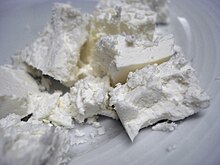 |
| Μαστίχα Χίου / Masticha Chiou | Chios | Masticha Chiou(Greek: Μαστίχα Χίου) is a resin obtained from the mastic tree (Pistacia lentiscus). It is also known as tears of Chios, being traditionally produced on the island Chios, and, like other natural resins, is produced in "tears" or droplets. Mastic is excreted by the resin glands of certain trees[129][130] and dries into pieces of brittle, translucent resin. When chewed, the resin softens and becomes a bright white and opaque gum. The flavor is bitter at first, but after some chewing, it releases a refreshing flavor similar to pine and cedar. |  |
| Μέλι Ελάτης Μαινάλου Βανίλια / Meli Elatis Menalou Vanilia | Greece | Menalou vanilia fir honey ( Rados, Stemnitsa, Syrna, Alonistaina, Vlacherna, Kardaras, Kapsas, Lykochia, Piana, Roeino, Tselepakos, and Chrysovitsi.[133]
|
|
| Μετσοβόνε / Metsovone | Greece | Metsovone ( milk. | 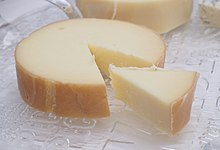 |
| Ρόδι Ερμιόνης / Rodi Ermionis | Peloponnese | Rodi Ermionis ( Protected Designation of Origin designation.[136] The ripe fruit has a round shape with a thin, fleshy, elastic and shiny skin, with the inside having arils that contain a soft, medium-sized, semi-woody seed that breaks easily with chewing. The color of the peel varies from pale yellow-pink to red (depending on the surface exposed to the sun) while the arils have a color that varies from pink to red. The Rodi Ermionis PDO can be applied to both the fresh fruit or to the hulled and packaged arils.[137]
|
|
| Τοματάκι Σαντορίνης / Tomataki Santorinis | Santorini | The Santorini tomato 'τοματάκι Σαντορίνης' (tomataki Santorinis) is a variety of cherry tomato from Santorini, Greece. Santorinis have a deep red color and have firm, not particularly moist flesh with a high seed content. They are known for their high carbohydrate content and a sweet, strongly acidic taste. They have a round, slightly flattened shape and weigh 15–27 grams. They often have pronounced flutes, especially those growing lowest on the plant. The fruits generally ripen in 80–90 days.[138] The Santorini tomato has been protected with an official designation of origin since June 13, 2013.[138] | |
| Ξυνομυζήθρα Κρήτης / Xynomyzithra Kritis | Crete | Xynomizithra or xynomyzithra ( |
Ireland
| Product name | Area | Short description | Image |
|---|---|---|---|
| Imokilly Regato | Ireland | Imokilly Regato ( European Union law in 1999.[141]
|
|
| Oriel Sea Minerals | Ireland | Oriel Sea Minerals (Irish: Mianraí Mara Oirialla) is a variety of Irish sea minerals.[142][143][144][145][146] Oriel Sea Minerals are concentrated sea mineral salts in liquid form and are harvested from the Irish Sea by Oriel Marine Extracts.[147][148] They are harvested from the bay of Port Oriel near Drogheda.[149] Oriel Sea Minerals received Protected designation of origin in 2016.[150][151][149][152][153] |  |
| Oriel Sea Salt | Oriel Sea Salt (Irish: salann sáile Oirialla) is a variety of Irish sea salt.[154] Oriel Sea Salt was established at Port Oriel, Clogherhead in 2010 by Brian Fitzpatrick and John Delany. It extracts and harvests salt and minerals from Irish Sea seawater.[155] It describes itself as "the only non-oxidised sea salt on the planet": the seawater is pumped from the seabed without being exposed to air, resulting in a naturally white salt with a fine powdery grain and a "smooth depth of flavour."[156] They received Protected designation of origin in 2016.[150][151][149] |  |
Italy
| Product name | Area | Short description | Image |
|---|---|---|---|
Aprutino Pescarese
|
Province of Pescara | Aprutino Pescarese is a Protected Designation of Origin (PDO) olive oil, produced in the province of Pescara, in the region of Abruzzo. It is among the first group[157] of Italian extra virgin olive oils to be registered as PDO. | |
| Asiago | Asiago | Asiago (Italian: Trentino-Alto Adige.[161] Asiago cheese is one of the most typical products of the Veneto region. It was, and still is, the most popular and widely used cheese in the DOP area where it is produced. The DOP production area is strictly defined: It starts from the meadows of the Po Valley and finishes in the Alpine pastures between the Asiago Plateau and the Trentino's highlands. The DOP designated area where the milk is collected and Asiago DOP cheese is produced extends to four provinces in the north-east of Italy: the entire area of Vicenza and Trento and part of the provinces of Padua and Treviso. Asiago cheese, which is produced and matured in dairies located more than 600 m (2,000 ft) above sea level, using milk from farms also more than 600 m (2,000 ft) above sea level, is entitled to the additional label "Product of the Mountains". Over time, production of asiago was initiated in other countries as well, particularly those with a history of notable immigration from Italy. As such, production of the cheese has spread around the globe and the term "asiago" describes a style of cheese that can be produced anywhere.[158]
|
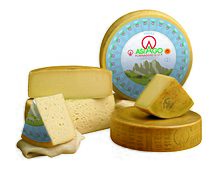 |
| Bitto | Valtelline
|
Bitto ( alpine meadows. The cheese received the DOP (Protected Denomination of Origin) recognition in 1996, with a less restrictive product specification than the traditional one. Since then, another version of Bitto, called Bitto Storico (Historical Bitto), has been produced by means of traditional methods and promoted by Slow Food (Slow movement). In September 2016 Bitto Storico changed its name to Bitto ribelle.[162]
|
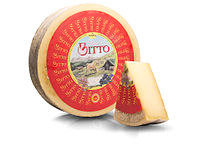 |
| Bra | Bra
|
The |  |
| Bruzio | Cosenza | Bruzio Protected Designation of Origin (PDO) product, as of European regulation Reg. CEE 2081/92 and Reg. CE n.1065/97.
|
|
Mozzarella di Bufala Campana
|
Campania | Mozzarella di Bufala Campana ( Denominazione di origine protetta scheme. The protected origin's appellation requires that it may only be produced with a traditional recipe in select locations in the regions of Campania, Lazio, Apulia and Molise .
|
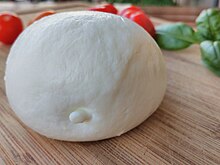 |
Caciocavallo silano
|
Southern Italy | Caciocavallo Italian pronunciation: cow's milk. It is produced throughout Southern Italy, particularly in the Apennine Mountains and in the Gargano peninsula. Shaped like a teardrop, it is similar in taste to the aged Southern Italian Provolone cheese, with a hard edible rind. Apparently caciocavallo was mentioned the first time around 500 BC by Hippocrates, emphasising the "Greeks' cleverness in making cheese".[167] Columella in his classic treatise on agriculture, De re rustica (35–45 CE), described precisely the methods used in its preparation, making it one of the oldest known cheeses in the world.[168] Types of cheese with names similar to "caciocavallo" are common throughout the Balkans and Southern Italy (Eastern Mediterranean).
In Sicily, the Ragusano DOP, known locally as caciocavallo ragusano had to drop the denomination "caciocavallo" in order to get DOP status.[169] |
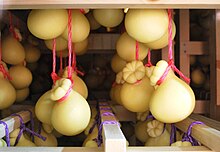 |
Capocollo di Calabria
|
Calabria | Capocollo di Calabria cold cut (salume) made from the dry-cured muscle running from the neck to the fourth or fifth rib of the pork shoulder or neck. It is a whole-muscle salume, dry cured, and typically sliced very thin. It is similar to the more widely known cured ham or prosciutto , because they are both pork-derived cold-cuts used in similar dishes. It is not brined as ham typically is.
|
 |
| Casciotta d'Urbino | Urbino | Casciotta d'Urbino or Casciotta di Urbino is a type of cow's milk. First made in ancient times, this cheese, it is said was a favourite of Michelangelo and Pope Clement XIV.[citation needed ] Local legend has it that the name came about from a mis-pronunciation of "caciotta" by a local civil servant; some say it is derived from the local dialect.
|
|
| Castelmagno | Piedmont | Castelmagno (DOP) is an Italian Protected Designation of Origin status in the European Union .
|
 |
| Cinta Senese | Province of Siena | The Cinta Senese (Italian pronunciation: FAO in the same year. At the end of 2012 there were 2543 pigs registered, distributed over 111 farms.
|
 |
| Culatello di Zibello | Zibello | Culatello di Zibello is similar to prosciutto but is made from the filet or loin of the hind leg. It is cured primarily with salt only and aged in a beef or hogs bladder as a casing to prevent spoilage and contamination. Culatello di Zibello possesses PDO status. It is commonly served as a starter. Strolghino is a salame prepared from leftover cuts of culatello.[177] |  |
| Fontina | Aosta Valley | Fontina (French: fontine[178]) is a cow's milk cheese, first produced in Italy. Over time, production of Fontina has spread worldwide, including the United States, Denmark, Sweden, Quebec, France and Argentina.[179][180] Fontina produced in the Aosta Valley must be made from unpasteurized milk from a single milking, with two batches being made per day.[181] The original fontina cheese from the Aosta Valley is fairly pungent and has quite an intense flavor, although fontina-like labeled cheeses that are produced in other countries can be much milder.[ |
 |
Formaggio di Fossa di Sogliano
|
Sogliano al Rubicone | Formaggio di Fossa di Sogliano is a cheese from Sogliano al Rubicone in the Emilia-Romagna region of Italy. The cheese's name, which literally means "cheese of the pit", is derived from the process of ripening the cheese in special pits dug in tuff rock. The cheese is currently produced in the areas between the Rubicon and Marecchia river valleys. In 2009 formaggio di fossa was granted Denominazione di Origine Protetta status, the Italian equivalent of Protected Designation of Origin (PDO).[187] |  |
| Formai de Mut dell'Alta Valle Brembana | Lombardy | Formai de Mut dell'Alta Valle Brembana is an Italian cheese prepared from raw cow's milk that originated in Lombardy, Italy.[174] It is prepared in a similar manner to Fontina d'Aosta cheese at Alta Valle Brembana in high pasture lands and in Bergamo, Lombardy.[188] It is rarely found outside of Lombardy, and it is produced in "very limited quantities".[188] It was classified with a protected designation of origin status[185] in 1996. |  |
| Nocellara del Belice | Valle del Belice | Nocellara del Belice is an extra-virgin olive oil, which is pressed from a minimum of 70% Nocellara del Belice olives.[189][190] As a table olive it may be treated by various methods, one of which is named for the comune of Castelvetrano in the Valle del Belice;[191] these may be marketed as Castelvetrano olives in the United States and elsewhere,[192] and are large, green olives with a mild, buttery flavor.[192][193] The Nocellara del Belice olive has two DOP protections: both Valle del Belìce DOP olive oil and Nocellara del Belice DOP table olives have protected status in the European Union.[189][191] Nocellara del Belice olives are grown primarily in Sicily,[194] but also in India, Pakistan and South Africa.[195]
|
 |
| Pane di Altamura | Altamura | Pane di Altamura is a type of Italian naturally leavened PDO status within Europe . By law, it must be produced according to a range of strict conditions, including using particular varieties of durum wheat (all locally produced), a certain specification of water, a consistent production method, and must also have a final crust that is at least 3 mm thick. The shape of the bread is not essential for a loaf to be certified, but there are some traditional shapes.
|
 |
Parmigiano Reggiano
|
Emilia-Romagna | Parmigiano Reggiano (Italian: [parmiˈdʒaːno redˈdʒaːno]) is an Italian hard, granular cheese produced from cow's milk and aged at least 12 months.
It is named after the producing areas, the |
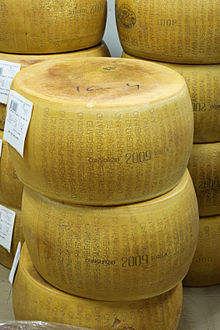 |
| Pecorino di Filiano | Basilicata | Pecorino di Filiano is a firm sheep milk. It was granted protected designation of Origin (PDO) in 2007.[199] Pecorino di Filiano is produced in the province of Potenza, in the communes of Atella, Avigliano, Balvano, Baragiano, Barile, Bella, Cancellara, Castelgrande, Filiano, Forenza, Ginestra, Maschito, Melfi, Muro Lucano, Pescopagano, Picerno, Pietragalla, Pignola, Potenza, Rapolla, Rapone, Rionero in Vulture, Ripacandida, Ruoti, Ruvo del Monte, San Fele, Savoia di Lucania, Tito, Vaglio, Vietri di Potenza.[200] Every year on the first Sunday of September in Filiano is organized the pecorino di Filiano festival, where the cheese, produced by various farmers, is available to taste and buy.[201]
|
 |
Pecorino romano
|
Central Italy | Pecorino romano (Italian pronunciation: legionaries of ancient Rome. Today, it is still made according to the original recipe and is one of Italy's oldest cheeses. On the first of May, Roman families traditionally eat pecorino with fresh fava beans during a daily excursion in the Roman Campagna. It is mostly used in Central and Southern Italy .
|
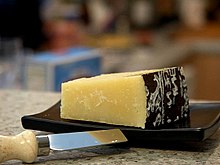 |
| Pecorino sardo | Sardinia | Pecorino sardo ( hard cheese made from fresh whole sheep's milk curdled using lamb or kid rennet. The mixture is poured into moulds that will give the cheese its characteristic shape. After a brief period in brine, the moulds are lightly smoked and left to ripen in cool cellars in central Sardinia. The average weight of the finished product is 3.5 kg (7.7 lb): sometimes a bit more, sometimes a bit less depending on the conditions of manufacture. The rind varies from deep yellow to dark brown in colour and encases a paste that varies from white to straw-yellow. The sharpness of the flavour depends on the length of maturation. The young pecorino sardo is about a couple of months old; the mature type is more than six months old and needs strictly controlled temperature and humidity.[204] In the United States it is most often found as a hard cheese, its more mature form. Pecorino sardo is not as well known outside Italy as romano or pecorino romano, although a good deal of pecorino romano is actually made in Sardinia, as Sardinia is within romano's PDO area. Pecorino sardo can be processed further into casu martzu by the introduction of cheese fly maggots .
|
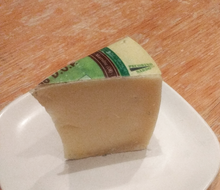 |
| Pecorino siciliano | Sicily | Pecorino siciliano DOP ( semi-hard white cheese, it has a cylindrical shape and a weight of about 12 kg (26 lb).[206] The cheese was awarded with Denominazione di Origine Protetta in 1955 and EU protected designation of origin status in 1996.[206]
|
|
| Pecorino toscano | Tuscany | Pecorino toscano (Tuscan pecorino) is a firm-textured protected designation of origin (PDO) status.[208]
|
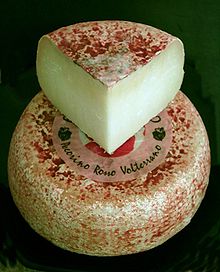 |
| Piave | Province of Belluno | Piave is an |  |
| Pomodorino del Piennolo del Vesuvio | Naples | The pomodorino del Piennolo del Vesuvio or sometimes just pomodorino vesuviano, is a |  |
Prosciutto di Parma
|
Emilia-Romagna | Prosciutto di Parma (Italian: Italian Speck, based on the South Tyrol region and also known as Speck Alto Adige PGI, which is also a dry-cured ham, prosciutto is not smoked. The names prosciutto and prosciutto crudo are generic, and not protected designations, and may name or describe a variety of hams more or less similar to Italian prosciutto crudo or other dry-cured hams worldwide.[215][216][217]
|
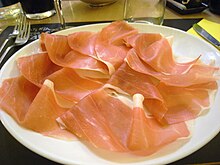 |
Provolone Valpadana
|
Casilli | Provolone Valpadana (pronounced Vesuvius, where it is still produced in pear, sausage, or cone shapes 10 to 15 cm (4 to 6 in) long. Provolone-type cheeses are also produced in other countries. The most important provolone production region today is Northwestern Italy and the city of Cremona. Provolone, provola, and provoleta are versions of the same basic cheese. Some versions of provolone are smoked.[218]
|
 |
| Quartirolo lombardo | Lombardy | Quartirolo lombardo ( cow's milk, which has a Protected Designation of Origin (PDO) status. The beginning of its production dates back to the 10th century. Its production was seasonal, the cheese was made at the end of the summer with the milk of cows that had eaten erba quartirola ("grass of the fourth"), that is the grass that had grown again after the third cut. Nowadays, it is made all year around, it has been recognised by the European Economic Community and registered in the PDP list with ECC Reg. n. 1107/96.[219]
|
 |
| Ragusano | Ragusa | Ragusano is an Italian | 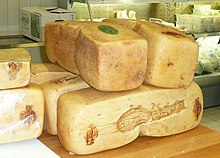 |
| Raschera | Cuneo | Raschera is an Italian pressed fat or medium fat, semi-hard cheese made with raw or pasteurized cow milk, to which a small amount of sheep or goat milk may be added. It has an ivory white color inside with irregularly spaced small eyes, and a semi-hard rind which is red gray sometimes with yellow highlights. It has a savory and salty taste, similar to Muenster cheese, and can be moderately sharp if the cheese has been aged. The cheese was given an Italian Protected Designation of Origin (DOP) in July 1996, and may also carry the name "di alpeggio" (from mountain pasture) if the cheese was made in the mountainous areas of its designated province of Cuneo.[221][222]
|
 |
| Robiola di Roccaverano | Langhe | Robiola di Roccaverano is an Italian La Tur has a cake-like rind over a tangy-lactic layer of cream and is representative of Piedmont's Robiola style of cheese where the fresh curds are ladled into molds, and drain under their own weight before aging rather than by pressing with weights. Robiola from the Piedmont region is a fresh cheese, and is usually eaten on its own, or with a little honey.
|
 |
| Sabina | Province of Rome | Sabina is a Aprutino Pescarese, Brisighella, Collina di Brindisi and Canino. The production area of the PDO extra virgin olive oil is mainly in two provinces, Rieti and Rome, and follows the borders of the ancient Sabine territory. Techniques used to produce the oil are almost the same as in pre-Roman times with necessary technological innovations. For the production of the extra virgin olive oil Sabina, the soil and the mild climate are of fundamental importance.[224]
|
|
Salva Cremasco
|
Crema | Salva Cremasco is a table cow's milk cheese made with raw curd in Crema. It is a washed-rind cheese that undergoes a medium or long aging period. Salva is traditionally eaten in the central plain of Lombardy and produced particularly in the area of Crema, Bergamo, and Brescia.[225] It is also produced in the provinces of Lecco, Lodi, and Milan. Salva has many similarities to Quartirolo, though differs from it by having longer aging and a major aromatic complexity. | |
Pomodoro San Marzano dell'agro sarnese-nocerino
|
Valle del Sarno | Pomodoro San Marzano dell'agro sarnese-nocerino is a variety of plum tomato. Amy P. Goldman calls the San Marzano "the most important industrial tomato of the 20th century"; its commercial introduction in 1926 provided canneries with a "sturdy, flawless subject, and breeders with genes they'd be raiding for decades".[226] Though commercial production of the San Marzano variety is most closely associated with Italy, seeds for the variety are available worldwide.[citation needed] It is an heirloom variety.[227] Canned San Marzanos, when grown in the Valle del Sarno ("valley of the Sarno") in Italy in compliance with Italian law, can be classified as pomodoro San Marzano dell'agro sarnese-nocerino and have the EU "DOP" emblem on the label. Most San Marzano tomatoes sold commercially are grown in Italy, though they are produced commercially in smaller quantities in other countries. Because of San Marzano's premium pricing, there is an ongoing battle against fraudulent product. On 22 November 2010, the Italian Carabinieri confiscated 1,470 tonnes (1,450 long tons; 1,620 short tons) of improperly labelled canned tomatoes worth €1.2 million.[citation needed] San Marzano tomatoes, along with pomodorino del Piennolo del Vesuvio, have been designated as the only tomatoes that can be used for Vera pizza napoletana ("true Neapolitan pizza").[228] |  |
| Silter | Province of Brescia | Silter is an Italian hard cheese made within the Alpine Lombardy region around Province of Brescia and surrounding areas and traditionally produced with unpasteurised cows milk during summer months and September,[229][230] is brined,[231] and aged for a minimum of six months.[229][230] As of 2015, within the EU, it has PDO certification.[232] | |
Soprèssa vicentina
|
Vicenza | Soprèssa vicentina Italian pronunciation: [soˈprɛssa] is an Italian aged salami, produced with pork, lard, salt, pepper, spices and garlic. It is a typical product of Veneto, in northern Italy. The sopressa is a salami, typical of the Venetian culinary tradition. The PDO requirements are governed through the "Consorzio di Tutela della Soprèssa Vicentina DOP", which brings together four local producers scattered around Vicenza. | 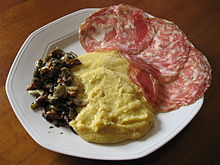 |
| Spressa delle Giudicarie | Trentino-Alto Adige/Südtirol | Spressa delle Giudicarie is an Italian cheese that comes from the region of Trentino-Alto Adige/Südtirol.[233] The Spressa delle Giudicarie can be consumed fresh after three months, while curing takes more than six months. The cheese is made in cylindrical shape, about 25 cm (9.8 in) in diameter. The crust is brown, the interior of the cheese is white to very pale yellow with small to medium-sized holes. The cheese is eaten when still young. It is a cow's milk cheese Rendena race mostly, from two milkings, the evening and the morning.[234] Originally, the milk was used to make butter. The skimmed milk that remained was used for cheeses. It pairs well with local wine, as Marzemino, red wine DOC from southern Trentino.[235] | |
| Taleggio | Val Taleggio | Taleggio (IPA: smear-ripened Italian cheese that is named after Val Taleggio . The cheese has a thin crust and a strong aroma, but its flavour is comparatively mild with an unusual fruity tang.
Taleggio and similar cheeses have been around since Roman times, with Cicero, Cato the Elder, and Pliny the Elder all mentioning it in their writings. The cheese was solely produced in the Val Taleggio until the late 1800s, when some production moved to the Lombardy plain to the south.[236] |
 |
| Terra d'Otranto | Terra d'Otranto
|
The extra-virgin olive oil Terra d'Otranto is produced with the olive cultivars Cellina di Nardò and Ogliarola for, at least, 60%.[237] They are mixed with other minor varieties of the local olive groves. Its name is linked with the historical region of Terra d'Otranto which included almost all the municipalities of the current provinces of Taranto, Brindisi and Lecce. It is recognised as PDO product.[citation needed] |  |
| Terre Tarentine | Taranto | The extra-virgin olive oil Terre Tarentine is produced with the olive cultivars Leccino and Coratina and Ogliarola for, at least, 80%. They are mixed with other minor varieties of the local olive groves. It is recognised as PDO product.[citation needed] | 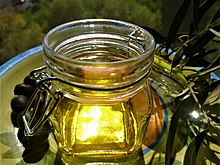 |
Toma piemontese
|
Aosta Valley | Toma piemontese is a semi-hard Italian cow's milk cheese, noted for its excellent melting qualities. Toma is made primarily in the Aosta Valley (it is one of the region's specialties[223]) and Piedmont regions of Northwestern Italy. The Toma piemontese is the Toma variety from Piedmont.[238] It can have a fat content of 45%–52%.
|
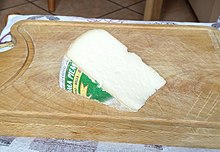 |
Aceto balsamico tradizionale di Modena
|
Modena | Aceto balsamico tradizionale di Modena ("Traditional balsamic vinegar") is a type of |  Barrels during aging |
| Valle d'Aosta Fromadzo | Valle d'Aosta
|
Valle d'Aosta Fromadzo or Vallée d'Aoste Fromadzo is an Italian cow's milk cheese produced in the Aosta Valley, one of the region's specialties. It has a protected designation of origin, or PDO status.[223] | |
| Valle d'Aosta Jambon de Bosses | Valle d'Aosta
|
Valle d'Aosta Jambon de Bosses is a spicy cured ham product[242] from Saint-Rhémy-en-Bosses in the Aosta Valley in Italy,[243] one of the region's specialties.[244][245] It was awarded European Union protected designation of origin (PDO) status.[223] | |
| Valle d'Aosta Lard d'Arnad / Vallée d'Aoste Lard d'Arnad | Vallée d'Aoste Lard d'Arnad Valle d'Aosta Lard d'Arnad or is a variety of bay, nutmeg, sage and rosemary.[247] The brining takes place in wooden tubs known as doïls, which may be made of chestnut, oak or larch, and are used solely for this purpose; it is known that Lard d'Arnad has been made for more than two centuries since a 1763 inventory from Arnad Castle refers to four doïls which belonged to its kitchens.[248] It is often eaten with black bread and honey.[243] The traditional Féhta dou lar (Arnad Francoprovençal patois for Lard Festival) is a Sagra held each year on the last Sunday of August. It has become a significant tourist attraction.
|
||
| Valtellina Casera | Valtellina | Valtellina Casera ( |  |
Latvia
| Product name | Area | Short description | Image |
|---|---|---|---|
Latvijas lielie pelēkie zirņi
|
Latvia | Latvijas lielie pelēkie zirņi (Latvian large grey peas) is a popular Latvian cuisine snack made from large grey peas. It is a traditional Christmas dish in Latvia. In 2015, it was registered as a PDO.[252] Dried peas of the "Retria" variety are best for these pea dishes, which differ from other smaller grey peas in their impressive size – 1000 peas weigh 360–380 g. Although their number in pods is not large, it is compensated by good culinary properties – relatively short cooking time, good taste properties. The State Institute of Crop Production (Latvian: Valsts Priekuļu laukaugu selcijas institūts) is probably the only place in the world where large grey peas are selected and grown for food.[252] The "Retriver" breed was also created here. The quality of peas is influenced by the appropriate Latvian soil and climatic conditions. |  |
Luxembourg
| Product name | Area | Short description | Image |
|---|---|---|---|
| Beurre rose – Marque nationale du Grand-Duché de Luxembourg | Luxembourg | "Beurre rose – Marque nationale du Grand-Duché de Luxembourg" is a cultured milk | |
| Miel – Marque nationale du Grand-Duché de Luxembourg | Luxembourg | Miel – Marque nationale du Grand-Duché de Luxembourg is a PDO status.[citation needed ]
|
Malta
| Product name | Area | Short description | Image |
|---|---|---|---|
Malta
|
Malta (island) | Malta or "of Malta" is a PDO wine from the | |
Gozo /Għawdex
|
Gozo | Gozo or of Gozo (Maltese: Għawdex or "Ta' Għawdex") is a PDO wine from the island of Gozo, with very similar requirement to those of "Malta".[257] |  |
Netherlands
| Product name | Area | Short description | Image |
|---|---|---|---|
Boeren-Leidse met sleutels
|
Western part of the Netherlands | Boeren-Leidse met sleutels (Farmers' Leiden with Keys) is a semi-hard cheese with a low fat content, made of unpasteurized milk and containing cumin seeds. The cheese was originally produced from the left-overs of butter-production near the city of Leiden. The cheese is coated with a red-brown cover showing two keys: the coat of arms of the city of Leiden.[258][259] |  |
| Kanterkaas / Kanternagelkaas / Kanterkomijnekaas | Friesland and the Westerkwartier
|
Kanterkaas / Kanternagelkaas / Kanterkomijnekaas are a group of Dutch cheeses made from cow's milk. The plain variety is called Kanterkaas. Apart from the plain variety, there is Kanterkomijnekaas which is flavored with cumin and Kanternagelkaas flavored with both cumin and cloves. Kanter is Dutch for 'edge' and refers to the sharp angle at the point where the side of the cheese wheel meets the base.[260] It was registered as a PDO in 2000.[261]
|
|
Mergelland
|
part of South Limburg | Mergelland is a wine produced on soil is composed of a layer of loess arable soil, with marl underneath. Several grapes are used for Mergelland wine: Riesling, Pinot noir, Pinot gris, Pinot blanc, Müller-Thurgau, Gewürztraminer, Dornfelder, Chardonnay and Auxerrois.[262] | |
Noord-Hollandse Gouda
|
Noord Holland
|
Noord Hollandse Gouda is a Gouda cheese from cow's milk Noord Holland using a specification which applies the 1911 Patent and Trade Mark Act for Cheese in addition to characteristics which are specific for the cheese.[263] | |
Rivierenland
|
along rivers in Gelderland | Rivierenland is a PDO for several types of wine (both white and red) produced from vineyards with a maximum production of 40–60 hectoliter/ha. It is produced in the province of Gelderland along the rivers Oude IJssel, IJssel, Nederrijn and Lek.[264] |
Poland
| Product name | Area | Short description | Image |
|---|---|---|---|
| Bryndza Podhalańska | Podhale | Bryndza Podhalańska is a Polish variety of the soft cheese Bryndza, from the Podhale region, it is made from sheep's milk.[265][266] | |
| Oscypek | Tatra Mountains | Oscypek (pronounced sheep milk exclusively in the Tatra Mountains region of Poland. Oscypek is made by an expert named "baca", a term also denoting a sheep shepherd in the mountains. The cheese is a traditional holiday cheese in some European countries and is often served with cranberry jam on the side. Since 14 February 2008 Oscypek has been registered as a PDO.[267]
|
|
| Redykołka | Podhale | Redykołka is a type of cheese produced in the Podhale region of Poland. It is sometimes known as the "younger sister" of the Oscypek cheese and the two are occasionally confused. The cheese is often made in the shape of animals, hearts, or decorative wreaths. |  |
Portugal
| Product name | Area | Short description | Image |
|---|---|---|---|
Carne Arouquesa
|
Portugal | Carne Arouquesa is meat from the Arouquesa: a cattle breed from Portugal.[268] The Arouquesa breed was registered as a PDO in 1996. |  |
| Bairrada | Beira Litoral Province | Bairrada is a wine from the eponymous Cantanhede, Mealhada and Oliveira do Bairro .
|
|
| Bucelas | Lisboa | Bucelas (historically known as Bucellas) is a Rhine. Urban sprawl in the 20th century has drastically reduced viticulture in the area, located north of the Portuguese capital city, Lisbon.[270]
|
 |
| Carcavelos | Carcavelos | Carcavelos is a off dry, topaz colored wines that have nutty aromas and flavors.[269] While once a thriving wine region, world-renowned in the 19th century for its tawny colored fortified wine, in the modern era Carcavelos has been devastated by real estate development in the suburbs of the capital city of Lisbon and nearby coastal city of Estoril.[271]
|
 |
Carne Cachena da Peneda
|
Viana do Castelo and Braga | Carne Cachena da Peneda is meat from Cachena: a breed of triple-purpose cattle from Portugal and Galicia, Spain. They are fed through grazing at high altitudes, except in winter, when they are fed closer to small population centres. The production area of the PDO comprises 743 km2.[272] |  |
Carne Marinhoa
|
Portugal | Carne Marinhoa is meat from the Marinhoa: a cattle breed from Portugal. A large animal with harmonious forms. Thick elastic and prominent skin; light brown coat, tending to straw; docile temperament; long and flat head; bulky but not large abdomen; long wide and deep back and topsides; muscled members, strong, with good angulation; dark mucous; small horns; sub-concave profile. The breed region is circumscribed almost exclusively to the Central Portugal in Aveiro District.[273] | |
Carne Maronesa
|
Serra do Marão | Carne Maronesa is meat from the Maronesa: a traditional Portuguese draught power.[274]
|
Parque Natural do Alvão |
Carne Mertolenga
|
Portugal | Carne Mertolenga is meat from the Mertolenga: a cattle breed from Portugal, one of thirteen registered Portuguese breeds (as of 2003), making up around 19 per cent of cattle in that country.[275] |  |
Carne Mirandesa
|
Portugal | Carne Mirandesa is meat of the Mirandesa, a cattle breed from Portugal. | |
| Colares | Colares | Colares is a tannins.[277]
|
|
| Dão | Região Demarcada
|
Dão is a Dão rivers in the north central region of Portugal.[278] The region became a Denominação de Origem Controlada (DOC) appellation in 1990. The Dão region is the origin of the Touriga Nacional vine that is the principal component of port wine.[279]
|
 |
| Douro | Trás-os-Montes e Alto Douro
|
Douro is a |  |
| Lagoa | Lagoa
|
Lagoa is a Lagoa municipality in the Algarve region. The region has Portugal's highest wine classification as a Denominação de Origem Controlada (DOC). The region is bordered to the west by the Portimão DOC and to the east by Tavira DOC. The region has been historically known for its fortified wine production but has been expanding its table wine production in recent years.[280]
|
|
| Lagos | Lagos | Lagos is a Portuguese wine region centered on the Lagos municipality in the Algarve region. The region has Portugal's highest wine classification as a Denominação de Origem Controlada (DOC). Located on the southwestern corner of Algarve, the region is bordered to the east by the Portimão DOC.[280] | |
Pêra Rocha do Oeste
|
Oeste | Pêra Rocha do Oeste (literally "rock pear of Oeste"[281]) is a native Portuguese variety of pear. The earliest account of the Rocha variety dates from 1836, in the Sintra municipality. This variety was casually obtained from a seed, on Pedro António Rocha's farm.[282] The variety derives its name from his family name. The 'Rocha' pear is produced in several places in Portugal. The production area is over 100 km2 and there are about 9,450 producers.[283] The PDO status was register in 2003.[284] | 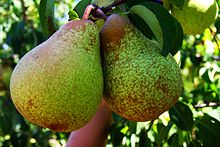 |
| Porto / Port / vinho do Porto / Port Wine / vin de Porto / Oporto / Portvin / Portwein / Portwijn | Porto | Porto / Port / vinho do Porto / Port Wine / vin de Porto / Oporto / Portvin / Portwein / Portwijn is a northern Portugal.[285] It is typically a sweet red wine, often served as a dessert wine, although it also comes in dry, semi-dry, and white varieties. Other port-style fortified wines are produced outside Portugal, in Argentina, Australia, Canada, France, India, South Africa, Spain, and the United States, but as a PDO, only Porto from the Porto region can be referred to as such.[286][287]
|
 |
| Portimão | Portimão | Portimão is a Portuguese wine region centered on the Portimão municipality in the Algarve region. The region has Portugal's highest wine classification as a Denominação de Origem Controlada (DOC). The region is bordered by the Lagoa DOC to the east and the Lagos DOC to the west.[280] | |
Presunto de Barrancos / Paleta de Barrancos
|
South-west of the Iberian Peninsula | Presunto is a | |
| Queijo de Azeitão | Azeitão | Queijo de Azeitão is a Portuguese Great Taste Awards.[289]
|
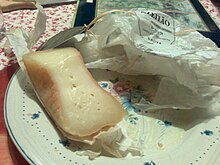 |
| Queijo de Cabra Transmontano / Queijo de Cabra Transmontano Velho | Alto Trás-os-Montes
|
Queijo de Cabra Transmontano (Transmontano Goat's Cheese) is a type of |  |
| Queijo de Nisa | Nisa | Queijo de Nisa is a semi-hard Alto Alentejo in Portugal. It is created from raw milk, which is coagulated, then curdled using an infusion of thistle. It is yellowish white, with a robust flavor and a somewhat acidic finish. Since 1996, Nisa cheese has a protected geographical status.[291] It was honored by the magazine Wine Spectator as one of the world's top 100 in an edition devoted to cheese: "100 Great Cheeses".[292]
|
 |
| Queijo do Pico | Pico | Cheese of Pico (Portuguese: Queijo do Pico) is a cheese originating from the island of Pico in the Portuguese archipelago of the Azores. It has been classified as a PDO since October 1996.[293][294] |  |
Queijo S. Jorge
|
São Jorge | São Jorge Cheese (Portuguese: Queijo São Jorge) is a semi-hard to hard cheese, produced on the island of São Jorge, in the Portuguese archipelago of the Azores, certified as a Região Demarcada do Queijo de São Jorge (Demarcated Region of the Cheese of São Jorge).[295][296] |  |
| Queijo Serpa | Serpa | Queijo Serpa is a type of cheese from Serpa, Alentejo, Portugal. It has a Protected designation of origin (PDO) and is listed on the Ark of Taste. | |
Queijo Serra da Estrela
|
Serra da Estrela | Serra da Estrela cheese (Queijo Serra da Estrela) is a Gouveia, Mangualde, Manteigas, Nelas, Oliveira do Hospital, Penalva do Castelo, Carregal do Sal and Seia .
|
 |
Requeijão Serra da Estrela
|
Serra da Estrela | Requeijão Serra da Estrela is a milk-derived product, produced in corn husks. The Portuguese product[298] is white to yellowish-white, solid, and usually having a characteristic strong taste; typically sold in specially designed draining plastic or basket-like weaved containers, or in plastic cups.
|
|
| Setúbal | Setúbal Municipality
|
Setúbal, or Moscatel de Setúbal, is a Muscat wines known as Moscatel de Setúbal. The style was believed to have been invented by José Maria da Fonseca, the founder of José Maria da Fonseca, the oldest table wine company in Portugal dating back to 1834. J.M. Fonseca company still holds a quasi-monopoly control over the production of Moscatel de Setúbal today.[299]
|
|
| Tavira | Algarve | Tavira is a | |
| Sal e Flor de Sal de Tavira DOP | Tavira | Sal Artesanal e Flor de Sal Artesanal de Tavira Salt from Tavira, Algarve, Portugal. It has a Protected designation of origin (PDO) since 2013 PDO. |
Romania
| Product name | Area | Short description | Image |
|---|---|---|---|
Telemea de Ibăneşti
|
Ibănești, Mureș | Telemea de Ibăneşti is the name of a Romanian cheese traditionally made of |  |
Slovakia
| Product name | Area | Short description | Image |
|---|---|---|---|
| Paprika Žitava / Žitavská paprika | Podunajská nížina
|
Paprika Žitava or Žitavská paprika indicating a specific production of Slovak Republic, in 2014.[303]
|
South Africa
| Product name | Area | Short description | Image |
|---|---|---|---|
| Rooibos / Red Bush | Western Cape and Northern Cape | Rooibos / Red Bush, meaning "red bush"; is tea made from the eponymous broom-like member of the plant family Fabaceae that grows in South Africa's fynbos. It contains between 0,02 and 1,16 % of aspalathin and up to 0,4 % nothofagin.[304]
|
 |
Spain
| Product name | Area | Short description | Image |
|---|---|---|---|
| Arzúa-Ulloa | Galicia | Arzúa-Ulloa cheese is a cow's milk cheese made in the Spanish autonomic region of Galicia, in Arzúa-A Ulloa.[305] It is a soft cheese, made from raw or pasteurized milk, has a minimum maturity period of six days, and has a lenticular shape, or cylindrical with rounded edges. Its rind is thin and pliant, medium to dark yellow, bright, clean and smooth. The cheese itself is uniform in color between white and pale yellow. It is soft and creamy without cracks but may have a few small holes or bubbles.
The flavour is slightly sweet and grassy.[306] It is similar in flavor to its cousin cheese, Tetilla. Unlike Tetilla cheese, Arzúa-Ulloa has a soft pliant rind, and has a disc shape. In addition to the PDO status, there are two other labels that the cheese may carry, farm-made Arzúa-Ulloa (Arzúa-Ulloa de Granxa), a cheese having the particularity that the milk comes entirely from cows on the same farm (its characteristics being otherwise similar), and aged Arzúa-Ulloa (Arzúa-Ulloa curado), a cheese that has been aged for at least six months, with the result that it is firmer in texture throughout. |
 |
| Cabrales | Asturias | Cabrales is a DO status.[307] The same is true of other Spanish blue cheeses, also traditionally leaf-wrapped, such as Valdeón and Picón Bejes-Tresviso .
|
 |
| Gamoneu / Gamonedo | Principality of Asturias
|
Gamoneu / Gamonedo is a fatty cylinders with flat ends in weights varying between 500g (18 oz) to 7 kg (15 lbs).[308]
|
 |
| Idiazabal | Basque Country | Idiazabal is a pressed Assaf sheep, which some maintain does not meet the Denomination of Origin for the cheese.[309]
|
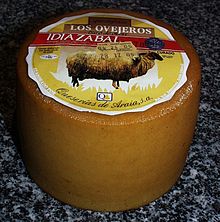 |
Jamón de Teruel / Paleta de Teruel
|
Teruel | Jamón de Teruel / Paleta de Teruel is a meat product from the Teruel region, which has PDO registration since 1996. | 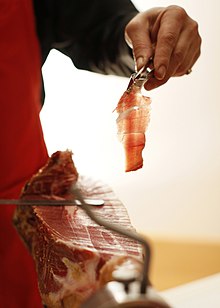 |
| Mahón-Menorca | Maó
|
Mahón-Menorca (formatge de Maó in the original Catalan, queso de Mahón in Spanish) is a soft to hard white | 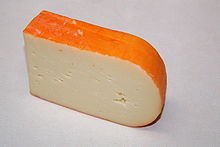 |
| Queso Palmero / Queso de la Palma | La Palma | Queso Palmero / Queso de la Palma is a Spanish plain or lightly smoked cheese from the island of |  |
| Picón Bejes-Tresviso | Cantabria | Picón Bejes-Tresviso is a foot odour,[313] it adds to the cheese's characteristic and complex aroma.
|
 |
Queso Casín
|
Principality of Asturias
|
Queso Casín is a Spanish cheese made in the Friesian and any crosses between these breeds.[314] Specifically the geographic area of manufacture is the southern part of Asturias which includes the Redes Natural Park (Parque Natural de Redes) and associated land, this is within the municipalities of Caso, Sobrescobio and Piloña.[315] The cheese is classified as hard and semi-hard, and can be semi-cured or cured. It takes its name from one of the breeds of cattle whose milk is used, in turn named after the town of Caso. The shape of the cheese is a thick disc-shape, sometime more conical, of 10–20 cm diameter and 4–7 cm in height. The weight is between 250 and 1,000 g (8.8 and 35.3 oz).[316]
|
 |
| Queso de Flor de Guía / Queso de Media Flor de Guía / Queso de Guía | Gran Canaria | Queso de Flor de Guía / Queso de Media Flor de Guía / Queso de Guía is a Spanish cheese ( globe artichoke are used to curdle the milk.[317][318] The cows are kept stabled for most of the year but when conditions are favourable they are tethered in open pasture. The goats are grazed on fenced land within the specified area and gathered in at night. The animals may be milked mechanically or manually. The former are conditions of the Spanish Denomination of Origin.[318]
|
 |
| Queso Majorero | Fuerteventura | Queso Majorero is a The goat produces a thick, aromatic and high-fat milk. |  |
Queso Nata de Cantabria
|
Cantabria | Queso de nata de Cantabria (English: Cantabrian cream cheese) is made from the milk of Friesian cows in Cantabria, an autonomous community in northern Spain. The cheese is registered as a PDO since 1985.[323] The production of the cheese is confined to all parts of Cantabria, except the areas of Tresviso and Menor de Bejes in the western part of the region. It is presented in forms of various weights from 400 – 2,800 g (14 ounces – 6 lbs). The size of the forms varies according to the weight.[324]
|
|
| Roncal | Valle de Roncal | Roncal (Erronkariko gazta in PDO status.[325]
|
 |
| Queso Tetilla / Queixo Tetilla | Galicia | Queso Tetilla / Queixo Tetilla is a regional cow's-milk cone topped by a nipple, or a half pear – hence its other name, perilla. It weighs from 0.5 to 1.5 kg, with a diameter and height ranging from 90 to 150 mm.
|
 |
Tierra del Vino de Zamora
|
Zamora
|
Tierra del Vino (literally, "the Land of Wine") is a Duero River as it winds its way through the province of Zamora, and is crossed from North to South by the Roman Silver Road, the Vía de la Plata. It covers a total surface area of 1,799 square kilometres, which extend throughout a total of 56 boroughs; 46 in the province of Zamora and a further ten in the province of Salamanca .
|
Sweden
| Product name | Area | Short description | Image |
|---|---|---|---|
| Kalix Löjrom | Bothnian Bay | Kalix Löjrom is the designation of the royal dinners and it is common on the Nobel prize banquets. Kalix Löjrom means literally "Kalix vendace roe". It is marketed as "Caviar of Kalix".[329]
|
 |
Turkey
| Product name | Area | Short description | Image |
|---|---|---|---|
| Taşköprü Sarımsağı | Taşköprü Sarımsağı | Taşköprü Sarımsağı is garlic from the variety Allium sativum var. sativum. possessing a bitter taste and strong smell. The geographical area of production comprises 1 811,31 km2 and is known for its garlic production.[330]
|
United Kingdom
| Product name | Area | Short description | Image |
|---|---|---|---|
| Bonchester cheese | Bonchester Bridge | Bonchester cheese is a soft Scottish cheese, made from unpasteurized Jersey cows' milk.[331] It is produced in Bonchester Bridge, Roxburghshire. | |
| Buxton Blue | Buxton | Buxton Blue is an English blue cheese that is a close relative of Blue Stilton, is made from cow's milk, and is lightly veined with a deep russet colouring.[332] It is usually made in a cylindrical shape. | |
West Country farmhouse Cheddar cheese
|
Cheddar, Somerset | West Country farmhouse Cheddar cheese, commonly known as cheddar, is a relatively hard, off-white (or orange if colourings such as annatto are added), sometimes sharp-tasting, natural cheese. Cheddar originates in the English village of Cheddar in Somerset.[333] | 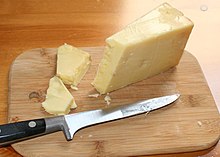 |
Cornish Clotted Cream
|
Cornwall | Cornish Clotted cream (Cornish: dehen molys, sometimes called scalded, clouted, Devonshire or Cornish cream) is a thick cream made by indirectly heating full-cream cow's milk using steam or a water bath and then leaving it in shallow pans to cool slowly. During this time, the cream content rises to the surface and forms "clots" or "clouts", hence the name.[334] It forms an essential part of a cream tea. |  |
| Dovedale cheese | Dovedale | Dovedale, sold as Dovedale Blue', is a Hartington Creamery in Derbyshire; a version is also produced by the Staffordshire Cheese Company in Cheddleton , Staffordshire.
|
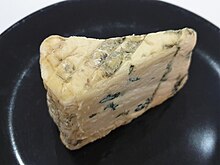 |
| Single Gloucester | Gloucester | Gloucester is a traditional, semi-hard cheese which has been made in Gloucestershire, England, since the 16th century. | |
| Lakeland Herdwick | Lake District
|
The Herdwick is a Protected Designation of Origin from the European Union.[336]
|
 |
| Jersey Royal potatoes | Jersey | The Jersey Royal is the marketing name of a type of Protected Designation of Origin (PDO). The potatoes are of the variety known as International Kidney and are typically grown as a new potato.[337] Under the Common Agricultural Policy of the European Union Jersey Royals are covered by a PDO.[338][339]
|
 |
Orkney lamb
|
North Ronaldsay | The North Ronaldsay or Orkney is a kelping (the production of soda ash from seaweed) on the shore became uneconomical. Sheep were confined to the shore to protect the fields and crofts inside, and afterwards subsisted largely on seaweed. This diet has caused a variety of adaptations in the sheep's digestive system. These sheep have to extract the trace element copper far more efficiently than other breeds as their diet has a limited supply of copper. This results in them being susceptible to copper toxicity, if fed on a grass diet, as copper is toxic to sheep in high quantities. Grazing habits have also changed to suit the sheep's environment. To reduce the chance of being stranded by an incoming tide, they graze at low tide and then ruminate at high tide. A range of fleece colours are exhibited, including grey, brown and red. Meat from the North Ronaldsay has a distinctive flavour, described as "intense" and "gamey",[340] due, in part, to the high iodine content in their diet of seaweed. The meat has Protected Geographical Status in European Union law, so only meat from North Ronaldsay sheep can be marketed as Orkney Lamb.Lamb meat and mutton from the sheep have been specially designated by the European Union, meaning that only pure-bred lambs can be marketed as "Orkney Lamb".[341] The meat has a unique, rich flavour, which has been described as "intense and almost gamey",[340] and has a darker colour than most mutton, due in part to the animals' iodine-rich diet.[340]
|
 |
Yorkshire Forced Rhubarb
|
West Yorkshire | The Rhubarb Triangle (or Tusky Triangle, Champagne and Parma Ham. Leeds Central MP, Hilary Benn, was involved in the Defra campaign to win protected status.[347][348]
|
 |
Shetland Lamb
|
Shetland Isles
|
The Shetland is a small, wool-producing Shetland Isles, Scotland, but is now also kept in many other parts of the world. It is part of the Northern European short-tailed sheep group, and it is closely related to the extinct Scottish Dunface. Shetlands are classified as a landrace or "unimproved" breed.[349] This breed is kept for its very fine wool, for meat, and for conservation grazing.[350]
|
 |
| White Stilton cheese / Blue Stilton cheese | Derbyshire, Nottinghamshire, Leicestershire | Stilton is an English cheese, produced in two varieties: Blue, which has had Penicillium roqueforti added to generate a characteristic smell and taste, and White, which has not. Both have been granted the status of a protected designation of origin (PDO) by the European Commission, requiring that only such cheese produced in the three counties of Derbyshire, Leicestershire and Nottinghamshire may be called "Stilton". The cheese takes its name from the village of Stilton, now in Cambridgeshire, where it has long been sold. Stilton cheese cannot be produced in Stilton village, which gave the cheese its name,[351] because it is not in any of the three permitted counties, but in the administrative county of Cambridgeshire and the historic county of Huntingdonshire. | 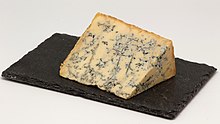 |
United States
| Product name | Area | Short description | Image |
|---|---|---|---|
| Napa Valley | Napa County, California | Napa Valley is an American Viticultural Area (AVA) located in Napa County in California's Wine Country. Napa Valley is considered one of the premier wine regions in the world.[352] Records of commercial wine production in the region date back to the nineteenth century,[353] but premium wine production dates back only to the 1960s.[352]
The combination of Mediterranean climate, geography and geology of the region are conducive to growing quality wine grapes. John Patchett established the Napa Valley's first commercial vineyard in 1858.[354] In 1861 Charles Krug established another of Napa Valley's first commercial wineries in St. Helena.[354] Viticulture in Napa suffered several setbacks in the late 19th and early 20th centuries, including an outbreak of the vine disease phylloxera, the institution of Prohibition, and the Great Depression. The wine industry in Napa Valley recovered, and helped by the results of the Paris Wine Tasting of 1976, came to be seen as capable of producing the best quality wine – equal to that of Old World wine regions. |
 |
Vietnam
| Product name | Area | Short description | Image |
|---|---|---|---|
Phú Quốc
|
Phú Quốc | Phú Quốc is a fish sauce (or fish extract) originating from Phú Quốc. The extract is produced through lysis, hydrolysis and self-fermentation of fish flesh by enzymes, most of which are contained in the internal organs of fish, and lengthy fermentation of the Clostridium bacterium in a fastidious condition at high temperature. The sauce is made up of locally caught fish, over 85% of which must be anchovies. Salt, and sometimes sugar, is added in the process.[355]
|
See also
- List of TSG products by country
Notes
- ^ The Rhubarb Triangle's geographical area in EU law is " from Ackworth Moor Top north along the A628 to Featherstone and Pontefract. Then on to the A656 through Castleford. It then goes west along the A63 past Garforth and West Garforth. Head north passing Whitkirk, Manston and on towards the A6120 by Scholes. Follow the A6120 west, round to pass Farsley which then leads south west via the A647 onto the A6177. Pass Dudley Hill to pick up the M606 south. At junction 26 take the M62 south to junction 25 head east along A644 toward Dewsbury, passing Mirfield, to pick up the A638 towards Wakefield. At Wakefield take the A638 south to Ackworth Moor top.[347]
References
- ^ "GI View". EU.
- ^ "Commission Implementing Decision of 12 September 2018 on the publication in the Official Journal of the European Union of the application for registration of a name referred to in Article 49 of Regulation (EU) No 1151/2012 of the European Parliament and of the Council — 'Istra' (PDO)". European Union.
- ^ "Publication of an application pursuant to Article 50(2)(a) of Regulation (EU) No 1151/2012 of the European Parliament and of the Council on quality schemes for agricultural products and foodstuffs (2015/C 186/08)". European Union.
- ^ "Commission Implementing Decision of 21 August 2017 on the publication in the Official Journal of the European Union of the single document referred to in Article 94(1)(d) of Regulation (EU) No 1308/2013 of the European Parliament and of the Council and of the reference to the publication of the product specification for a name in the wine sector (Maasvallei Limburg (PDO))". European Union.
- ^ "Publication of an application pursuant to Article 6(2) of Council Regulation (EC) No 510/2006 on the protection of geographical indications and designations of origin for agricultural products and foodstuffs". European Union.
- ^ "Cheese specialities from Vorarlberg – A mini study of cheeses". Urlaub in Vorarlberg. Retrieved 2018-08-13.
- ^ "DOOR". European Commission.
- ^ [1][dead link]
- ^ "Die Geschichte – Südtiroler Speck GGA". Archived from the original on 2009-06-22. Retrieved 2009-05-21.
- ^ "Bregenzerwälder Alp- und Bergkäse , bmlrt.gv.at". www.bmlrt.gv.at. Retrieved 2021-04-01.
- ^ "Bregenzerwälder Bergkäse » Hartkäse aus dem Bregenzerwald". Alles über Käse (in German). 2011-10-24. Retrieved 2021-04-01.
- ^ "Recherches historiques sur les produits du terroir wallon (Cellule d'Appui aux Indications géographiques) – Projet SPW DGARNE – Collaboration avec Ulg-Gembloux AgroBio Tech". Université de Namur (in French). Archived from the original on 9 January 2015. Retrieved 9 January 2015.
- ^ "CAIG : Cellule d'appui scientifique pour répondre à la demande de développement de produits sous AOP, IGP et STG". Laboratoire Qualité et Sécurité des Produits Agroalimentaires (Université de Liège-Gembloux AgroBio Tech) (in French). Retrieved 9 January 2015.
- ^ "Pôle de l'histoire environnementale de l'Université de Namur (PolleN)". Université de Namur (in French). Retrieved 9 January 2015.
- ^ Beurre d'Ardenne AO info (French) OMPI Resources
- ^ Beurre d'Ardenne Profile, European PDO/PGI Database, European Commission
- ^ "Българско бяло саламурено сирене / Bulgarsko byalo salamureno sirene". European Union. Retrieved 17 September 2023.
- ^ "龙井茶 / Longjing cha". European Union. Retrieved 2 October 2021.
- ^ Directorate-General for Communication (12 April 2021). "Halloumi now registered as a Protected Designation of Origin". European Commission registers Χαλλούμι/Halloumi/Hellim as a Protected Designation of Origin (PDO). Retrieved 20 January 2024.
- ^ "Commission Implementing Decision of 4 December 2015 on the publication in the Official Journal of the European Union of the single document referred to in Article 94(1)(d) of Regulation (EU) No 1308/2013 of the European Parliament and of the Council and of the reference to the publication of the product specification for a name in the wine sector [Dons (PDO)]". European Commission. Retrieved 1 August 2023.
- ^ "Application for Registration of Lapin puikula". European Commission. Retrieved 2 October 2021.
- ^ "Décret n° 2007-949 du 15 mai 2007 modifié relatif à l'appellation d'origine contrôlée " Abondance "". Institut national de l'origine et de la qualité. 2007. Archived from the original on 18 December 2012. Retrieved 6 November 2011.
- ^ "Un savoir-faire – Abondance". fromageabondance.fr.
- ISBN 9780199330904. Retrieved 10 January 2020.
- ^ "Syndicat de Défense du Fromage Beaufort, le fromage des alpages de Savoie". Archived from the original on 2012-07-19. Retrieved 2012-09-02.
- ^ "PRODUIT: Beaufort (Version du 03/06/2003 )". Institut national de l'origine et de la qualité. Retrieved 4 December 2012.
- ^ Hermine, Frédérique (8 April 2009). "Le beaufort capitalise sur le tourisme montagnard". Les Marches. La société ABC (Agro Business Communications). Archived from the original on 14 July 2014. Retrieved 4 December 2012.
- ^ eAmbrosia
- ^ Fiche produit
- ^ Beurre d'Isigny PDO registration, European Commission Denomination Information
- ISBN 978-0-89480-762-6. Retrieved 19 April 2021.
- ^ ISBN 978-1-4521-1149-0. Retrieved 19 April 2021.
- ISBN 978-0-19-933090-4. Retrieved 2021-04-19.
- ^ ISBN 978-1-4654-4372-4. Retrieved 2021-04-19.
- ^ "Delicious Corsica: Sampling the best of Corsican cuisine". National Geographic. 8 April 2019. Archived from the original on 13 July 2019. Retrieved 1 October 2021.
- ISBN 978-1-59077-269-0. Retrieved 2021-04-19.
- ^ "Brocciu Cheese-France: French Cheese Guide".
- ISBN 2263001778.
- ^ Chemical Society (Great Britain) (1882). Journal of the Chemical Society. Chemical Society. p. 441. Retrieved 9 April 2021.
- ^ "Pour l'Europe, AOP et AOC ne font plus qu'une". fromage-cantal.com/. Archived from the original on 28 November 2011. Retrieved 7 January 2012.
- ISBN 978-1-59257-714-9. Retrieved 2016-05-19.
- ISBN 978-0-19-933089-8. Retrieved 9 April 2021.
- ^ ISBN 978-0-19-933090-4. Retrieved 9 April 2021.
- ^ ISBN 978-1-250-06345-8. Retrieved 9 April 2021.
- ISBN 978-1-4236-0651-2. Retrieved 9 April 2021.
- ^ ISBN 0-19-860990-6.
- ^ "Not all wines with bubbles are Champagne". Kentucky Courier-Journal. 13 December 2011.
- ISBN 9780199330904. Retrieved 5 September 2019.
- ^ "The Comté Market (Le marché du Comté)". Retrieved August 18, 2016.
- ^ Detailed at cheese.com resource.
- ISBN 978-2-7430-6569-0. Retrieved 13 Apr 2021.
- ^ L'Epoisses AOP – Gaugry Fromager
- ^ "Figue de Solliès". TasteAtlas. Retrieved 8 February 2022.
- ^ Cracknell, Carmen (7 August 2017). "Fig season arrives early". The Connexion. Retrieved 8 February 2022.
- ^ "Règlement (CE) no 1367/2011 de la Commission du 19 décembre 2011 enregistrant une dénomination dans le registre des appellations d'origine protégées et des indications géographiques protégées [Figue de Solliès (AOP)]". Journal officiel de l'Union européenne. Retrieved 8 February 2022.
- ISBN 978-1-119-04615-8. Retrieved 2021-04-09.
- ISBN 0-7513-0896-X.
- ISBN 978-0-19-933089-8. Retrieved 2021-04-09.
- ^ "AOC". Fourme d'Ambert et de Montbrison. Archived from the original on 2007-02-11. Retrieved 2007-11-23.
- ISBN 978-0-89480-762-6. Retrieved March 30, 2018.
- ISBN 978-0-19-933089-8. Retrieved March 30, 2018.
- ^ "Lautrec Pink Garlic". Ail Rose de Lautrec. Syndicat de défense du Label Rouge et de l'IGP Ail rose de Lautrec. Archived from the original on February 3, 2017. Retrieved June 29, 2019.
- ^ "L'histoire de l'Ail Rose de Lautrec". ailrosedelautrec.com (in French). Syndicat de défense du Label Rouge et de l'IGP Ail rose de Lautrec. Archived from the original on February 24, 2017. Retrieved June 29, 2019.
- ^ "Commission Regulation (EC) No 1107/96 of 12 June 1996 on the registration of geographical indications and designations of origin under the procedure laid down in Article 17 of Council Regulation (EEC) No 2081/92". EUR-Lex (in French). Publications Office of the European Union.
- ISBN 9781442227156.
- ^ a b "Regions of France | Auvergne Region of France – Food & Gastronomy – Puy Lentis". www.regions-of-france.com. Retrieved 2017-04-14.
- ^ "BBC – Food – Puy lentils recipes". Retrieved 2017-04-14.
- ^ Rae, Amanda (20 July 2015). "Aspen Times Weekly: Wheels on Fire". Aspen Times. Retrieved 9 April 2021.
- ^ Williams, Ingrid K. (18 July 2018). "On the Normandy Cheese Trail". The New York Times. Retrieved 9 April 2021.
- ^ ISBN 978-0-89480-762-6. Retrieved 9 April 2021.
- ISBN 978-1-118-14552-4. Retrieved 9 April 2021.
- ISBN 978-1-4521-1149-0. Retrieved 9 April 2021.
- ISBN 978-0-19-933090-4. Retrieved 2021-04-09.
- ^ Guru, Cheesy (June 21, 2020). "All You Need to Know About Neufchâtel Cheese". Archived from the original on April 13, 2021. Retrieved October 1, 2021.
- ^ "Neufchatel". Cheese.com. Retrieved 2021-04-09.
- ^ Fletcher, Janet (2003-01-09). "Ossau-Iraty an earthy delight from France's Basque region". The San Francisco Chronicle.
- ^ ISBN 978-1-4654-4372-4. Retrieved December 11, 2017.
- ISBN 0-7513-0896-X.
- ^ Leanne Kitchen The Dairy 2008 – Page 149 "Pont-l'évêque – Named after the village in Normandy where it supposedly first appeared, this cheese is one of the most popular in France. An old cheese, it dates from at least the 12th century, when it was made by monks; it was once known as 'white meat' as it was eaten instead of meat on fasting days. Pont l'évêque is a cow's milk cheese, with a full, rich, sweet, slightly tangy flavour profile and a thin brownish rind; it is very similar to livarot, another washed-rind......"
- ^ Le Petit Futé Normandie – Page 58 2011 "Une Appellation d'Origine Contrôlée permet à un fromage de se distinguer. ... Le meilleur du pont-l'évêque vient du pays d'Auge; quant au livarot, il est fabriqué au sud-ouest du Calvados et au nord-ouest de l'Orne."
- ^ Le Petit Futé Deauville – Honfleur 2012 (avec cartes, photos + avis des lecteurs) – Page 44 2012 "L'étiquette "Fabriqué en Normandie" ne signifie pas, par exemple, que le fromage a été élaboré avec du lait normand ! Dans le cas de l'AOC on est certain ! Le pont-l'évêque et le livarot ont également obtenu leur AOC. Le meilleur du pont-l'évêque vient du Pays d'Auge..."
- ^ Isabelle Cauty, Jean-Marie Perreau – Conduite du troupeau bovin laitier – Page 32 2009 "les fromages à pâte molle à croûte lavée (la croûte subit, au cours de l'affinage, des lavages et des brossages à l'origine d'un goût plus marqué) ex : le Munster, l'Epoisses, le Maroilles, le Pont-l'évêque, le Livarot, le vacherin... "
- ISBN 0-7513-0896-X.
- ^ Fox, Patrick. Cheese: Chemistry, Physics and Microbiology. p. 200.
- ISBN 1-59373-029-2.
- Business Week. 31 December 2001.
- ^ "ROQUEFORT: ORIGINS". www.roquefort.fr. Archived from the original on 21 September 2019. Retrieved 19 May 2019.
- ISBN 9781845933777.
- ^ "Histoire du fromage Saint Nectaire".
- ISBN 0-7513-0896-X.
- ^ "Selles-sur-Cher". Maison du Lait. Archived from the original on 2007-07-05.
- ^ "AOC Selles-sur-Cher". INAO. Archived from the original on September 4, 2012.
- ^ "Wine Tasting, Vineyards, in France". wineterroirs.com.
- ISBN 0062011553
- ^ Gooch, Ellen (Spring–Summer 2006). "Truth, Lies, and Feta: The Cheese that Launched a (Trade) War". Epikouria: Fine Foods and Drinks of Greece. Triaina Publishing. Archived from the original on 5 July 2009.
- ^ Pappas, Gregory (2015). "Feta Cheese at the Heart of Growing US-EU Trade Tensions". The Pappas Post. Elite CafeMedia Lifestyle.
- ^ Various (2010). COUNCIL REGULATION (EC) No 510/2006, 'ΦΙΡΙΚΙ ΠΗΛΙΟΥ' (FIRIKI PILIOU), EC No: EL-PDO-0005-0540-27.03.2006 PDO ( X ) PGI ( ) (Report). European Union. Official Journal of the European Union. Retrieved March 16, 2017.
- .
- ^ "Formaela (cheese), Arachova-Delphi". Greekguide.com. B2B TECH. Archived from the original on August 7, 2016. Retrieved June 2, 2016.
- ^ "Greece: Υπουργική Απόφαση Αριθ. 313063, Αναγνώριση προστατευόμενης ονομασίας προέλευσης (Π.Ο.Π.) του τυριού 'ΦΟΡΜΑΕΛΑ ΑΡΑΧΩΒΑΣ ΠΑΡΝΑΣΣΟΥ' (FORMAELA ARACHOVAS PARNASSOU)" (in Greek). World Intellectual Property Organization. Retrieved June 2, 2016.
- ^ a b "Formaela". Gourmed. Archived from the original on June 6, 2016. Retrieved June 2, 2016.
- ^ "Graviera from Crete". Archived from the original on 2017-01-17. Retrieved 2021-10-01.
- ISBN 978-1563058486. p. 28.
- ISBN 978-1-74179-228-7.
Kalamata olive.
- ^ Quinn, Jennifer (29 July 2004). "Selling porkies – an almighty pie fight". BBC News Online Magazine. Retrieved 21 May 2011.
- ^ "Kalamon and Kalamata Olives – legislation changes the name". Archived from the original on 2014-05-19.
- ^ "On the different varieties of Greek olives". Archived from the original on 2018-06-17. Retrieved 2021-10-01.
- ^ "What is the difference between Kalamon olives and Kalamata olives?". Archived from the original on 2017-10-01. Retrieved 2016-05-01.
- ^ "Greek Olive Species".
- ^ "Olive Cultivars of South Africa". Archived from the original on 2018-09-24. Retrieved 2021-10-01.
- ^ Merriam-Webster Unabridged – kasseri
- ^ a b eAmbrosia
- ^ "The Art of Making Kasseri", Epikouria Magazine, Fall/Winter 2006
- ISBN 978-1563058486
- ^ EU Kefalograviera Profile (accessed 23 May 2009)
- ^ European Commission (26.6.2012). Publication of an amendment application pursuant to Article 6(2) of Council Regulation (EC) No 510/2006 on the protection of geographical indications and designations of origin for agricultural products and foodstuffs.(2012/C 186/09). Accessed on 04/01/2013.
- ^ WIPO (n.d.) Ministerial Decision No. 313046, Recognition of Protected Designation of Origin (P.D.O.) for the Cheese "KOPANISTI". Accessed on 07/01/2013.
- ^ "Kopanisti – Arca del Gusto".
- ^ "Publication of an amendment application pursuant to Article 6(2) of Council Regulation (EC) No 510/2006 on the protection of geographical indications and designations of origin for agricultural products and foodstuffs (2012/C 186/09)". eur-lex.europa.eu. Archived from the original on 6 December 2018.
- ^ Boukouvala, Evridiki; et al. (2014). Study of the Lactic Acid Bacteria during ripening in the traditional cheese of Lesvos island "Ladotyri". INTERNATIONAL SCIENTIFIC SYMPOSIUM BIOENGINEERING OF ANIMAL RESOURCES, International Scientific Symposium BIOENGINEERING OF ANIMAL RESOURCES 2014. Timișoara.
- ^ "Λαδοτύρι Μυτιλήνης PDO". qualigeo. Archived from the original on August 11, 2018. Retrieved July 11, 2018.
- ^ ANNEX I, APPLICATION FOR REGISTRATION: Art. 5 ( ) Art. 17 (X) PDO (X ) PGI ( ) National application No: TY (PDO) 9 (EU Act EL/PDO/0017/0445). 1996. Retrieved July 26, 2018.
- ^ "Regulation (EC) No. 1107/96 of 12 June 1996 on the registration of geographical indications and designations of origin under the procedure laid down in Article 17 of Council Regulation (EEC) No. 2081/92 with corrections published in the Official Journal of 13 November 1996". WIPO.int. Retrieved July 12, 2018.
- ^ "Manouri - Cheese.com". www.cheese.com. Retrieved 26 May 2017.
- ^ a b "Greek Manouri Cheese – How It's Made and How to Cook With It". Archived from the original on 6 April 2015. Retrieved 26 May 2017.
- ^ "Manouri / Manoypi". www.cheeselibrary.com. Archived from the original on 18 October 2019. Retrieved 26 May 2017.
- ^ "All We Can Eat – Say Cheese: A whey with manouri". Retrieved 26 May 2017.
- ^ EU Manouri Profile (accessed 23 May 2009)
- ISSN 0031-9422.
- ^ "Masticha Chiou". Database of Origin and Registration. European Commission Agriculture and Rural Development. Retrieved 29 August 2017.
- ^ "Μέλι Ελάτης Μαινάλου Βανίλια". European Commission.
- ^ "Sugar analysis of "Menalou vanilia" fir honey". International Bee Research Association.
- ^ "EL/PDO/0017/0453". European Commission.
- ^ "APPLICATION FOR REGISTRATION: Art. 5 ( ) Art. 17 (X) PDO (X) PGI ( ) National application Mo: TY (PDO) 19". ec.europa.eu. Archived from the original on 2012-11-03.
- ^ "European Commission – PRESS RELEASES – Press release – COMMISSION APPROVES THE REGISTRATION OF AGRICULTURAL AND FOOD PRODUCTS". europa.eu.
- ^ EU Agriculture [@EUAgri] (October 12, 2020). "We have a new Greek Protected Designation of Origin! #EUQuality" (Tweet) – via Twitter.
- ^ "Rodi Ermionis DOP". qualigeo.eu (in Italian). 2020. Retrieved October 12, 2020.
- ^ a b "'ΤΟΜΑΤΑΚΙ ΣΑΝΤΟΡΙΝΗΣ' (TOMATAKI SANTORINIS)". Official Journal of the European Union. Retrieved 2020-06-28.
- ^ Application for Registration for Xynomyzithra Kritis Cheese PDO
- ^ Department of Agriculture, Food and the Marine (2012). "Scéimeanna Comharthaithe Geografaigh" [Geographical Signing Schemes] (PDF). Tuarascáil Bhliantúil (in Irish). 2011. Archived from the original (PDF) on 19 July 2013. Retrieved 15 February 2019.
- ^ "COMMISSION REGULATION (EC) No 2107/1999 of 4 October 1999". Official Journal of the European Communities (2107/1999). European Commission: L 258/3. 5 October 1999. Archived from the original (pdf) on 15 February 2019. Retrieved 22 December 2011.
- ^ "Oriel Sea Minerals Ltd – Irish Company Info – SoloCheck". www.solocheck.ie.
- ^ "Concentrated Deep Sea Magnesium and Mineral Extract is a liquid free ion supplement – Oriel Sea Salt". orielrevive.com.
- ^ Nick, Callan. "CREED WELCOMES PROTECTED DESIGNATION STATUS FOR ORIEL SEA SALT AND ORIEL SEA MINERALS". merrionstreet.ie.
- ^ "European Commission – PRESS RELEASES – Press release – Daily News 31 / 08 / 2016". europa.eu.
- ^ "Food news: protected status for Oriel sea salt and sea mineral extract – Independent.ie". 11 September 2016.
- ^ "Oriel Sea Salt and Sea Minerals Granted Protected Designation of Origin by the EU – TheTaste.ie". 13 September 2016.
- ^ Murphy, Mark. "Oriel Sea Salt Given EU Protected Status".
- ^ a b c Finn, Christina (4 September 2016). "Sea salts that hail from Louth get EU 'protected status'". TheJournal.ie.
- ^ a b "Oriel Sea Salt Company news – Oriel Sea Salt". orielseasalt.com.
- ^ ISBN 9781509907809– via Google Books.
- ISBN 9781509907809– via Google Books.
- ^ D'Arcy, Ciaran. "Baas and blaas: the untapped potential of EU protection". The Irish Times.
- ^ "Oriel Sea Salt harvest a powerful Mineral Sea Salt that allows up to 25% salt reduction. Organic Approved. – Oriel Sea Salt". www.orielseasalt.com.
- ^ "What makes Oriel Sea Salt different from the rest". The Irish Times.
- ^ Costello, Rose. "Salt: It's all pretty much the same, so why are the prices so wildly different?". The Irish Times.
- ^ In the same regulation also: Brisighella, Collina di Brindisi, Canino and Sabina.
- ^ a b "U.S. TRADEMARK APPLICATION NO. 85655744 – ASIAGO – BIR-04-TM". tmng-al.uspto.gov. Archived from the original on 2020-10-09. Retrieved 2020-10-05.
- ^ "Asiago cheese needn't come from Italy, IP Australia rules". Lawyerly. 2018-06-05. Retrieved 2021-01-27.
- ^ Consorzio Tutela Formaggio Asiago Archived 2007-09-29 at the Wayback Machine, the consortium overseeing the use of the name Asiago.
- ^ "Where Asiago is produced – Consorzio Tutela Formaggio Asiago". Consorzio Tutela Formaggio Asiago. Archived from the original on 2016-04-06. Retrieved 2021-10-01.
- ^ "La guerra del Bitto: lo storico formaggio cambierà nome". Corriere della Sera (in Italian). 5 July 2016. Retrieved 19 April 2021.
- ^ Formaggio.it – Bra (Italian) (accessed 2 January 2008)
- ^ Cheese.com – Bra (accessed 2 January 2008)
- ISBN 88-8499-111-0
- ^ "Mozzarella di Bufala .org – il marchio dop". www.mozzarelladibufala.org. Archived from the original on 2008-05-09. Retrieved 2021-10-01.
- ^ "Caciocavallo Silano DOP – Background". Archived from the original on 11 September 2011. Retrieved 22 September 2011.
- OCLC 7459647.
- ^ "I formaggi storici di nicchia in Sicilia: aspet on ti produttivi e di mercato" (PDF) (in Italian). December 2007. p. 62. Archived from the original (PDF) on 2 April 2012. Retrieved 22 September 2011.
- ISBN 9780198606178
- ^ Canepari, Luciano. "Dizionario di pronuncia italiana online". dipionline.it. Retrieved 22 September 2019.
- ^ Canepari, Luciano. "Dizionario di pronuncia italiana online". dipionline.it. Retrieved 22 September 2019.
- ^ Dan Nosowitz. "How Capicola Became Gabagool: The Italian New Jersey Accent, Explained." Atlas Obscura. 5 November 2015. Retrieved 20 September 2016.
- ^ ISBN 978-1-4236-0651-2. Retrieved May 19, 2016.
- ^ Maria Rosito (2008). Cinta senese, rinascita di una razza (in Italian). Eurocarni (3): 196.
- ^ Norme tecniche del Libro Genealogico e del Registro Anagrafico della specie suina: Allegato 1 a D.M. 11255 del 13 June 2013 (in Italian). Ministero delle Politiche Agricole Alimentari e Forestali. pp. 8–9. Accessed September 2013.
- ISBN 9780847828739.
- ^ Dicitonnaire Larousse
- ^ "Fontina". www.belgioioso.com. Retrieved 2020-12-28.
- ISBN 978-1-4516-8972-3.
- ISBN 88-8499-111-0
- ^ 'The history' Archived 2014-07-25 at the Wayback Machine, Cooperativa Produttori Latte e Fontina (2006).
- ^ Fontina on Cheese.com
- ^ "Artisanal Premium Cheese". Archived from the original on 2010-08-08. Retrieved 2010-05-02.
- ^ a b "Fontina Val d'Aosta". Cheese.com. Retrieved 11 April 2016.
- ^ "Tasting Fontina Cheese".
- ^ Agraria.org
- ^ a b c Jenkins, Steven. 1996. Cheese Primer. New York: Workman Publishing Company, Inc. 186–188.
- ^ a b Valle del Belìce DOP Archived 2016-03-04 at the Wayback Machine (in Italian). Camera di Commercio Trapani. Accessed June 2015.
- ISBN 978-0-393-08348-4
- ^ a b Nocellara del Belìce DOP Archived 2016-03-04 at the Wayback Machine (in Italian). Camera di Commercio Trapani. Accessed June 2015.
- ^ a b Gold, Amanda (March 1, 2009), "Olive lovers clamor for the Castelvetrano", San Francisco Chronicle
- ISBN 978-0-643-09950-0
- ISBN 978-92-5-105347-8
- FAOSeed and Plant Genetic Resources Service, 2008
- ^ Case C-132/05 Commission v Germany European Commission Legal Service, July 2008 Archived 2019-04-05 at the Wayback Machine
- ^ "Most Parmesan Cheeses in America Are Fake, Here's Why". Forbes. November 19, 2012. Retrieved 2015-05-13.
... that it has earned the nickname in the dairy industry, 'The King of Cheeses.'
- ^ Ruggeri, Amanda (2019-01-28). "Italy's practically perfect food". Retrieved 2019-02-01.
- ^ "Pecorino di Filiano PDO". ec.europa.eu. Retrieved 3 January 2015.
- ^ "Pecorino di Filiano – Disciplinary of production" (PDF) (in Italian). pecorinofiliano.it. Retrieved 3 January 2015.
- ^ "Italian pecorino". ItaliaRegina.it.
- ^ Verucci, Damiana (18 October 2016). "Lazio contro Sardegna, scoppia la guerra del pecorino romano" [Lazio against Sardinia, the Roman pecorino war breaks out]. Il Tempo (in Italian).
- ^ ‘Pecorino sardo Dop’, SardegnaAgricoltura, (Regione Autonoma della Sardegna, 2009).
- ^ "Italian Pecorino Sardo Maturity". ItaliaRegina.it.
- ^ "Italian Pecorino Siciliano". Avial GROUP. Retrieved 6 June 2021.
- ^ a b Francesco Picciolo. Curiosità e ricette della mia cucina siciliana. Errant, 2013. p. 7.
- ^ www.formaggio.it, Pecorino Toscano (in Italian)
- ^ "Denomination Information". Agriculture and Rural Development. European Commission. Retrieved 11 December 2012.
- ^ DOP / PDO – Piave Cheese Consortium: The consortium overseeing the use of the name Piave
- ^ Production zone – Piave Cheese Consortium
- ^ "Agriform". Archived from the original on 2015-10-03. Retrieved 2021-10-01.
- ^ EU Directory of PDO/PGI/TSG – Pomodorino del Piennolo del Vesuvio profile (accessed 31/Oct/2010)
- ^ Agricoltura del Regione di Campania – News – Pomodorino del Piennolo del Vesuvio Archived 2011-07-22 at the Wayback Machine (Italian) (Accessed 31/Oct/2010)
- ^ Bruno Migliorini, Carlo Tagliavini, Piero Fiorellihan and Tommaso Francesco Bórri. "prosciutto". Dizionario d'ortografia e di pronunzia. Archived from the original on 2018-06-12. Retrieved 2021-10-01.
{{cite web}}: CS1 maint: multiple names: authors list (link) - ^ Fabricant, Florence (October 2, 2017). "A New American Prosciutto". The New York Times.
- ^ El Artesano, "1st Argentinian Prosciutto"
- ^ "Ακροκώλιον, το καλύτερο ελληνικό προσούτο φτιάχνεται στην Ευρυτανία", viewtag.gr, September 14, 2016 [2]
- ^ Great Chicken Dishes. p. 165.
- ^ (in Italian) Disciplinare di produzione della Denominazione di origine del formaggio "Quartirolo lombardo" DPCM 10 maggio 1993 – Gazzetta Ufficiale n. 196 of 21st August 1993
- ^ Amata, F.; Licitra, G.; Mormorio, D. (2000). Ragusano: Heritage and Landscape : the Art of Traditional Cheese-making. Consorzio Ricerca Filiera Lattiero-Casearia. pp. 133–134. Retrieved August 16, 2017.
- ISBN 9780199330881. Retrieved 3 December 2016.
- ^ Zeppa, Giuseppe (2004). "Raschera". Dairy Science and Food Technology. Retrieved 21 September 2016.
- ^ ISBN 978-1-4507-5291-6.
- ^ For the details on production area, cultivar and organoleptic traits refer to the production regulation Production Technical Regulation of the PDO extra virgin olive oil "Sabina"
- ^ "Disciplinare Salva Cremasco" (PDF). Retrieved 28 May 2014.
- ^ Phelan, Benjamin (August 30, 2012). "Awesome Sauce". Slate. Retrieved 2012-09-11.
- ^ "San Marzano Tomato". bonnieplants.com. Retrieved 16 April 2015.
- ^ "Regulations for obtaining the use of the collective trade mark "Verace Pizza Napoletana" Production Rules ('Il Disciplinare')" (PDF). Associazione Verace Pizza Napoletana.
- ^ a b Formaggio.it Entry (Italian Language) (Accessed November 2015)
- ^ a b Italiancheese.org Entry Archived 2016-03-04 at the Wayback Machine (Accessed November 2015)
- ISBN 88-8499-111-0
- ^ EU PDO Certification information (Accessed Nov/2015).
- ^ "Spressa delle Giudicarie cheese, Italian Cow cheese made in Trentino Alto Adige". Archived from the original on 2014-03-10. Retrieved 2021-10-01.
- ^ Formaggi tipici italiani: Spressa delle Giudicarie DOP
- ^ "Disciplinare di Produzione della Denominazione di Origine Protetta "Spressa delle Giudicarie". Retrieved 16 October 2014.
- ISBN 1400050340.
- ISSN 2171-9292.
- ^ Ministero Politiche Agricole Alimentari Forestali e Del Turismo. "Diciottesima revisione dell'elenco dei prodotti agroalimentari tradizionali".
- ^ EC Council Regulation No. 813/2000
- ^ EC Council Regulation No. 583/2009
- ^ Giudici, P.; M. Gullo; L. Solieri; P. M. Falcone (2009). Technological and Microbiological Aspects of Traditional Balsamic Vinegar and their influence on Quality and Sensorial Properties. Advances in Food and Nutrition Research, vol. 58.
- ISBN 978-88-365-2538-6. Retrieved May 21, 2017.
- ^ ISBN 978-88-365-3085-4.
- ISBN 978-2-7469-2857-2.
- ^ "Gusto Raro: Jambon de Bosses DOP - Italian typical ham". Retrieved 2 September 2011.
- ISBN 978-2-7469-2857-2.
- ^ The specific herbs and spices listed here are from it:Lardo
- ^ "Enogastronomia Valle d'Aosta/ Œnogastronomie Vallée d'Aoste" (PDF). Regione autonoma Valle d’Aosta / Région autonome Vallée d'Aoste. p. 4. Archived from the original (PDF) on 2011-08-23. Retrieved 2021-10-01.
- ^ a b Valtellina Casera Archived 2013-12-13 at the Wayback Machine, Consorzio Tutela Formaggi Valtellina Casera e Bitto.
- ^ EUR-Lex – 31996R1263 – EN
- ^ Consorzio Tutela Formaggi Valtellina Casera e Bitto, homepage.
- ^ a b Latvijas lielie pelēkie zirņi Archived 2021-06-09 at the Wayback Machine pvd.gov.lv
- ^ "Beurre Rose – Marque Nationale du Grand-Duché de Luxembourg – Local Butter From Luxembourg". Taste Atlas. 4 January 2020. Retrieved 24 January 2020.
- ^ "Beurre Rose – Marque Nationale du Grand-Duché de Luxembourg DOP". Qualigeo: The food, wine and spirits Geographical Indications database (in Italian). Retrieved 24 January 2020.
- ^ Beurre Rose Profile, European Commission PDO/PGI Database
- ^ "Existing Wine Names – Technical file: Malta". European Commission. Retrieved 28 December 2021.
- ^ "Existing Wine Names – Technical file: Gozo/Għawdex". European Commission. Retrieved 28 December 2021.
- ^ "Boeren-Leidse met Sleutels". Boerenleidsekaas. Retrieved 5 October 2021.
- ^ "Council Regulation (EEC) No 2081/92 Application for registration under Article 17. PDO. National application NO 004/94". European Commission. Archived from the original on 2021-10-05. Retrieved 2021-10-05.
- ^ "Publication of an application for registration pursuant to Article 6(2) of Regulation (EEC) No 2081/92 on the protection of geographical indications and designations of origin". Official Journal of the European Communities. 42. European Commission: C 378/2–4. 30 December 1999. Retrieved 12 March 2014.
- ^ "Commission Regulation (EC) No 1903/2000". Official Journal of the European Communities. 43. European Commission: L 228/55–56. 8 September 2000. Retrieved 12 March 2014.
- ^ "Commission Implementing Decision of 28 August 2017 on the publication in the Official Journal of the European Union of the single document referred to in Article 94(1)(d) of Regulation (EU) No 1308/2013 of the European Parliament and of the Council and of the reference to the publication of the product specification for a name in the wine sector (Mergelland (PDO))". European Commission.
- ^ "Council Regulation (EEC) No 2081/92 Application for registration under Article 17. PDO. National application NO 002/94". European Commission. Archived from the original on 2021-10-05. Retrieved 2021-10-05.
- ^ "Publication of the single document referred to in Article 94(1)(d) of Regulation (EU) No 1308/2013 of the European Parliament and of the Council and of the reference to the publication of the product specification for a name in the wine sector 2022/C 315/06". European Commission.
- ^ European Commission (2006-09-23). "Publication of an application pursuant to Article 6(2) of Council Regulation (EC) No 510/2006 on the protection of geographical indications and designations of origin for agricultural products and foodstuffs". Retrieved 2008-06-10.
- ^ Commission, European (2007-06-11). "Commission Regulation (EC) No 642/2007 of 11 June 2007 registering a name in the Register of protected designations of origin and protected geographical indications Bryndza Podhalańska (PDO)". Retrieved 2008-06-10.
- ^ "COMMISSION REGULATION (EC) No 127/2008". eAmbrosia – the EU geographical indications register. Retrieved 19 October 2020.
- ISBN 978-1-84593-466-8.
- ^ ISBN 0-7566-1324-8
- ISBN 0-19-860990-6
- ISBN 1-84000-332-4
- ^ "Carne Cachena da Peneda PDO". Portuguese Traditional Products. Retrieved 4 October 2021.
- ^ "Bovinos \ Raça Marinhoa". Fotografias de Raças Autóctones (in Portuguese). Ruralbit Lda. Retrieved 30 June 2011.
- ^ Breed data sheet: Maronesa/Portugal. Domestic Animal Diversity Information System of the Food and Agriculture Organization of the United Nations. Accessed June 2017.
- ^ Institut national de la recherche agronomique (2003): Animal research, Volumes 52–53, EDP Sciences S.A. (France).
- ^ a b c Asimov, Eric (3 August 2017). "Colares, Where the Vineyards Snake Through the Sand". The New York Times. Retrieved 4 August 2017.
- ^ ISBN 0-7566-1324-8
- ISBN 1-84000-332-4
- ISBN 0-19-860990-6
- ^ ISBN 0-7566-1324-8
- ^ "History" (in Portuguese). ferreiradasilva.pt. Retrieved 5 January 2017.
- ^ "The Rocha Pear, a taste of Portugal". 1883magazine.com. Archived from the original on 6 January 2017. Retrieved 5 January 2017.
- ^ J.M. Silva; N.G. Barba; M.T. Barros; A. Torres-Paulo (2005-04-30). "Rocha', the Pear from Portugal". Acta Hort. (ISHS) 671. pp. 219–222. Retrieved 2010-09-15.
- ^ Pêra Rocha do Oeste in the DOOR database of the European Union. Retrieved 2014-03-16.
- ISBN 0-02-863601-5
- ^ Labelling of wine and certain other wine sector products Europa.eu
- ^ "Office of the Law Revision Counsel, U.S. House of Representatives" Archived 11 May 2013 at the Wayback Machine
- ^ Presunto de Barrancos in the DOOR database of the European Union. Accessed 16 March 2014.
- ^ "Azeitão cheese among the best products in the world". Boas Notícias. 10 November 2014. Archived from the original on 3 March 2016. Retrieved 27 July 2016.
- ^ Transmontano Goat's Cheese Presidis Slow Food
- ^ Queijo de Nisa in the DOOR database of the European Union.
- ^ "The World of Cheese: 100 Great Cheeses" (Intro) on winespectator.com.
- ^ "Queijo do Pico" (in Portuguese). Ponta Delgada (Azores), Portugal. 2004–2012. Archived from the original on 13 May 2008. Retrieved 19 April 2012.
- ^ Queijo do Pico in the DOOR database of the European Union. Retrieved 2014-03-14.
- ^ José Leal Armas, Contribuição para a História da Produção de Leite e Lacticínios nos Açores, separata do Boletim do Instituto Histórico da Ilha Terceira, volume XLIV, Angra do Heroísmo, 1986.
- ^ José Pereira da Cunha da Silveira e Sousa Júnior, Os lacticínios na Região Açoriana Ocidental, Angra do Heroísmo, 1887.
- ^ EU Serra da Estrela Profile (accessed 23 May 2009)
- ^ a b Fernandes, Daniel. "Produtos Tradicionais Portugueses". Produtos Tradicionais Portugueses. Retrieved Mar 3, 2021.
- ^ ISBN 0-7566-1324-8
- ^ About Telemea at cheese.com
- ^ "EU reference site". European Commission.
- doi:10.5219/1120.
- ^ "Paprika Žitava". tasteatlas.com. Retrieved February 17, 2020.
- ^ "Publication of an application for registration of a name pursuant to Article 50(2)(a) of Regulation (EU) No 1151/2012 of the European Parliament and of the Council on quality schemes for agricultural products and foodstuffs 2020/C 190/08 C/2020/3563". European Commission. Retrieved 5 October 2021.
- ^ "Arzúa-Ulloa Cheese in Spain: Spanish food from Galicia | Spain.info in english". Archived from the original on 2013-05-24. Retrieved 2021-10-01.
- ^ "Arzúa Ulloa | Culture: The word on cheese". Archived from the original on 2012-06-18. Retrieved 2012-08-11.
- ^ a b [3] Official Spanish government regulatory board (in Spanish: see ext. refs for translation)
- ^ "Asturias | Queseros y Quesos de España". Queseros.com. Retrieved 2012-05-22.
- ^ Schmitt, Maggie (May 27, 2009). "Sheep vs. Sheep in Basque Country". The Atlantic.
- ^ "Queso Palmero o Queso de la Palma" (in Spanish). Ministerio de Medio Ambiente y Medio Rural y Marino. Archived from the original on April 14, 2009. Retrieved 2009-04-14.
- ^ "Queso Palmero" (in Spanish). Queseros.com. 2008-08-02. Retrieved 2012-12-07.
- ^ Pićon-Bejes-Tresviso (in Spanish) [dead link]
- ^ Betsy's Bacteria Archived 2005-01-20 at the Wayback Machine Wheaton College Quarterly
- ^ "Denominación de Origen Protegida 'Queso Casín'" [Denomination of Protected Origin 'Casín Cheese']. MAGRAMA.gob.es (in Spanish). Madrid, Spain: Ministerio de Agricultura, Alimentación y Medio Ambiente [Ministry of Agriculture, Food and the Environment]. 12 March 2013. Archived from the original on 6 October 2014. Retrieved 4 October 2014.
- ^ [4] Professional Cheesemakers Organisation – in Spanish
- ^ [5] Spanish Government Regulatory Board – Translation
- ^ "Islas Canarias | Queseros y Quesos de España". Queseros.com. Retrieved 2012-01-06.
- ^ a b "Ministerio de Agricultura, Alimentación y Medio Ambiente Marm.es". Mapa.es. Retrieved 2012-01-06.
- ISBN 978-1-4236-0368-9.
- ^ "European Commission PDO database". Retrieved 21 March 2013.
- ISBN 978-0-8118-5743-7.
- ISBN 978-84-8476-025-2.
- ^ "Error". www.mapa.gob.es.
- ^ "Cantabria | Queseros y Quesos de España".
- ^ Agriculture and Rural Development. "Denomination Information: Roncal". European Commission. Retrieved 2009-11-11.
- ^ a b c Denominación de Origen Protegida "Queso Tetilla" Archived 2016-03-03 at the Wayback Machine (in Spanish). Ministerio de Agricultura, Alimentación y Medio Ambiente. Accessed January 2016.
- ^ "Council regulation (EC) No 510/2006 "Kalix löjrom"". European Commission. Retrieved 10 October 2010.
- ^ European Commission: Agriculture and Rural Development: Agriculture and food: DOOR: [registered Swedish products]
- ^ Caviar of Kalix www.caviarofkalix.com
- ^ "Publication of an application for registration of a name pursuant to Article 50(2)(a) of Regulation (EU) No 1151/2012 of the European Parliament and of the Council on quality schemes for agricultural products and foodstuffs 2020/C 436/11 C/2020/9207". European Commission. Retrieved 5 October 2021.
- ^ Il portale di Formaggio Bonchester cheese Accessed 18 January 2014 Archived September 28, 2007, at the Wayback Machine
- ^ The Foody – Cheese basics
- ^ Smale, Will (21 August 2006). "Separating the curds from the whey". BBC Radio 4 Open Country. Retrieved 7 August 2007.
- ^ "BBC – Devon Great Outdoors – Tony Beard's Dartmoor Diary".
- National Geographic Magazine. 182 (2). National Geographic Society.
- ^ "Protected status for Lakeland Herdwick sheep". BBC. May 16, 2013.
- ISBN 978-0-521-31623-1.
- ^ "Policy paper Protected food name: Jersey royal potatoes (PDO)". London: TSO. 7 August 2007. Retrieved 2015-03-16.
- ^ Jersey Royal
- ^ a b c Hollweg, Lucas (3 February 2008). "The Virtues of North Ronaldsay Lamb". The Sunday Times. Archived from the original on March 1, 2017. Retrieved 4 March 2017.
- ^ "Product Specification – "Orkney Lamb"" (PDF). gov.uk. DEFRA. Retrieved 2 December 2016.
- ^ Tusky Tale – Dalesman, Dalesman, 3 March 2008, archived from the original on 23 May 2020, retrieved 8 December 2018
- ISBN 1-903425-89-1
- ^ Map of the Week, BBC, retrieved 4 March 2010
- ^ Rhubarb Triangle, Morley Archives, archived from the original on 10 November 2010, retrieved 21 February 2010
- ^ Application to register Yorkshire Forced Rhubarb (PDF), DEFRA, archived from the original (PDF) on 2013-08-22, retrieved 25 February 2010
- ^ a b Yorkshire rhubarb joins Europe's protected food elite, DEFRA, archived from the original on 22 August 2013, retrieved 17 April 2016
- ^ Bates, Stephen (25 February 2010), "European Protection", The Guardian, retrieved 25 February 2010
- ^ "Shetland". Sheep101.info. Retrieved 18 June 2015.
- ^ "The Shetland Breed". The Shetland Sheep Society. Archived from the original on 29 November 2012. Retrieved 18 June 2015.
- ^ Charles, Aaron-Spencer (December 28, 2011). "Cheese made in Stilton not allowed to be called Stilton – it's the law". Retrieved December 28, 2011.
- ^ a b Robinson, Jancis (September 6, 2008). "California – Tasting Notes & Wine Reviews from Jancis Robinson". jancisrobinson.com. Archived from the original on April 4, 2014. Retrieved January 2, 2011.
- ^ A Memorial and Biographical History of Northern California. Chicago: Lewis Publishing Co. 1891. Archived from the original on March 27, 2009. Retrieved January 2, 2011.
- ^ a b Brennan, Nancy (November 21, 2010). "John Patchett: Introducing one of Napa's pioneers". Napa Valley Register. Retrieved January 2, 2011.
- ^ "Publication of an application pursuant to Article 6(2) of Council Regulation (EC) No 510/2006 on the protection of geographical indications and designations of origin for agricultural products and foodstuffs3". European Commission. Retrieved 5 October 2021.

